Mary Anne Yarde's Blog: The Coffee Pot Book Club , page 162
December 6, 2018
Christmas in Camelot — Gawain and the Green Knight, by Mary Anne Yarde Christmas #Arthurian #Legends
 Christmas in Camelot — Gawain and the Green KnightBy Mary Anne Yarde
Christmas in Camelot — Gawain and the Green KnightBy Mary Anne Yarde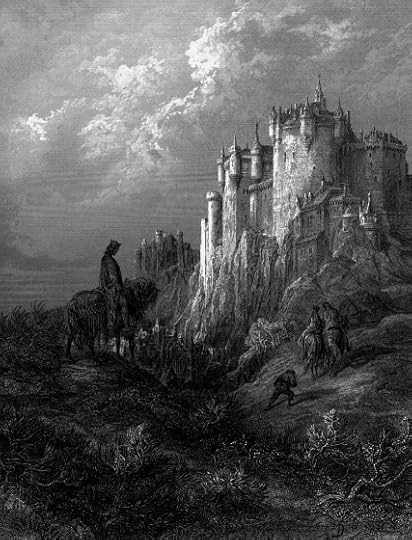 Gustave Doré's illustration of Camelot from Idylls of the King 1867 ~ Wikipedia
Gustave Doré's illustration of Camelot from Idylls of the King 1867 ~ WikipediaIn the 14th Century, a poet — whose name has been lost over time, but is now referred to as The Pearl Poet — wrote an epic Arthurian poem. This is how The Pearl Poet described Christmas at Camelot.
“…then they brought the first course, with the blast of trumpets and the waving of banners, with the sound of drums and pipes, so that many a heart was uplifted at the melody. Costly and most delicious foods were carried in. Many were the dainties, delicacies and fresh meats, so great was the plenty they might scarce find room on the board and table-cloth to set all the silver dishes. Each helped himself as he liked best, and for each of two guests were twelve dishes served, with a great plenty of beer and bright wine…”
According to The Pearl Poet, Arthur knew how to throw a party! One would expect a feast at the Midwinter/ New Year celebrations, but perhaps not on such a grand scale.There would have been music and entertainment at such a feast. I should imagine there were jugglers and those with what we would call Circus Skills!
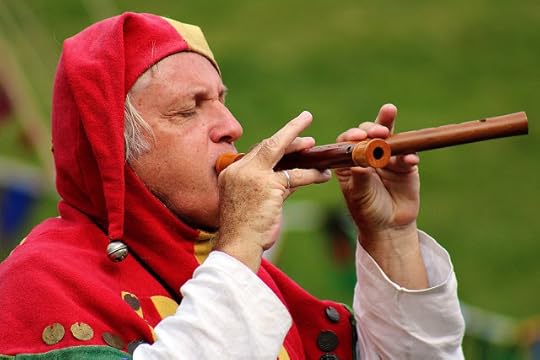
Bards would tell wonderful stories to entertain the guests — perhaps they told stories of Arthur and his Knights — and as the evening wore on, old men would become philosophical, as they contemplated mortality.
But there is one story about a Christmas feast that every Arthurian enthusiasts will know, and this story is:
Gawain and the Green Knight
By The Pearl Poet
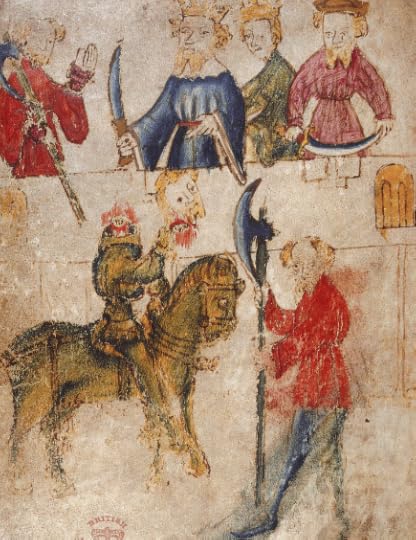 Sir Gawain and the Green Knight (from original manuscript, artist unknown) ~ Wikipedia
Sir Gawain and the Green Knight (from original manuscript, artist unknown) ~ WikipediaIf you are not familiar with the story, then read on for a very abridged version with a little of my own poetic licence thrown into the mix!
New Year's Day, Camelot
The Knights of Camelot were celebrating the New Year in Arthur's Great Hall. Food was a plenty, and the mead was freely flowing. Friends and family gathered around the fire pit to listen as a bard wove the most fantastical tale.
Sir Gawain was content to sit and listen to the bard. There was nothing that needed his attention. This was a time to relax and rejoice. The New Year promised to be a good one. The Kingdom was at peace, for the most part, and everything was as it should be.
But this tranquillity was soon quashed when someone pounded against the great oak door of the Hall. The door rattled on its hinges. The bard fell silent, as did everyone else. All eyes turned towards the door and everyone held their breath.
The door opened and there, on a horse the colour of spring grass, was a giant of a man. The giant's skin, like that of his horse, was an unnatural shade of green. Without a by-or-leave, the giant rode his horse into the Hall and dismounted. In his hand was a monster of an axe. This Green Knight narrowed his eyes and looked around him with a contemptuous sneer.
"Is this Arthur's court?" the giant asked, his voice was so loud that some of the women shrieked. "Are these his Knights?"
"It is," Arthur said, rising to his feet. "They are. What can we do for you?"
The Green Knight smiled, showing a perfect set of green teeth. "Your knights are the bravest in the land, or so I am told, and the most chivalrous. Well, we will see about that. I wonder if there is any knight amongst you that would be brave enough to accept a challenge from me."
All the Knights looked to Arthur… But one.
"I will accept your challenge," Sir Gawain said, rising from his seat.
"Gawain, no,” Arthur ordered under his breath.
"Brave boy," the Green Knight snarled. "Or a foolish one. Take my axe, Sir Knight, and chop off my head."
"Why? Do you not like life?" Gawain asked, taking the axe from the Green Knight. The axe was so heavy that Gawain had a job to lift it.
"I do not fear for my life, but perhaps you should fear for yours."
A block was brought forth, and the Green Knight knelt.
"Aim true," he stated.
Shaking his head, Gawain lifted the axe and then with a sickening thud, he took the head from the Green Knight’s shoulders.
The silence that followed was deafening. But then something strange happened. The Green Knight’s headless body stood, and his hands reached for his severed head.
"Meet me at the Chapel Green this time next year, so that I can return the favour," the decapitated head said, and then he left.
Gawain watched as the door closed behind the Green Knight. He turned to face his King with a look of horror.What had he done? There was no way he could survive such a strike.
The year that passed was uneventful, but each day Gawain knew he was a step closer to his death. As the leaves turned from green to brown and the first snow began to fall. Gawain tacked up his horse and, with a heavy heart, he set out for the Chapel Green.
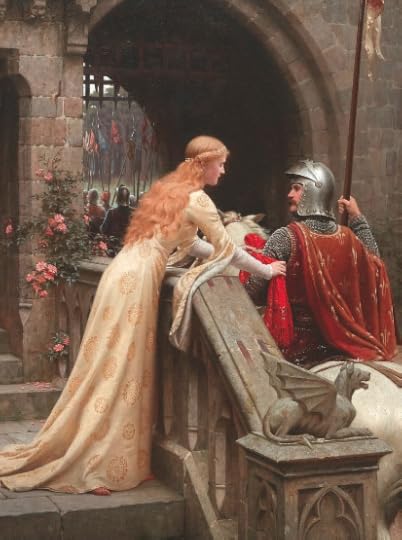 God's Speed by Edmund Blair Leighton 1900 ~ Wikipeida
God's Speed by Edmund Blair Leighton 1900 ~ WikipeidaAfter many weeks of traveling he happened upon a castle, and there he was greeted by Bertilak de Hautdesert and his beautiful wife. Berilak asked Gawain why he was here and Gawain told him only that he had promised to meet someone at the Chapel Green on New Year's Day. Bertilak assured him that the Chapel was just two miles away. Bertilak then, very kindly, invited him to stay with them. Gawain thanked Bertilak and took him up on his generous offer.
The next day Bertilak went hunting. But before he departed he told Gawain that he was more than welcome to stay as long as whatever he might gain during the day, he gave back.
Gawain frowned at such a riddle, but later in the day, all became clear. Bertilak's beautiful wife began to tease him. Gawain had never met anyone like her. She was intoxicating. So very beautiful. Gawain found himself clenching his fists to stop himself from reaching for her. One kiss, he finally allowed, when he could not take it anymore. Just one kiss. I will take nothing more, for Bertilak is my host.
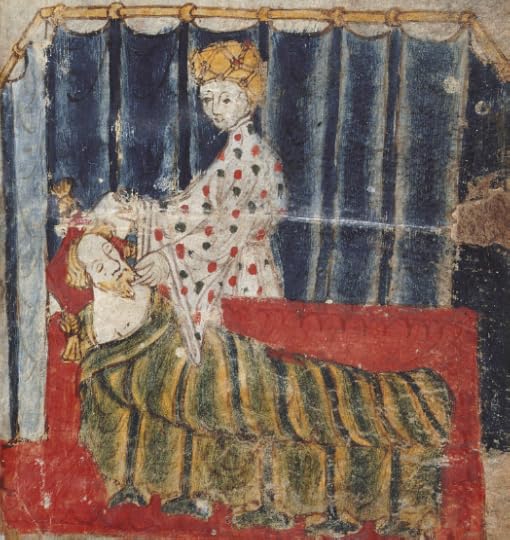 Lady Bertilak at Gawain's bed ~ from original manuscript, artist unknown ~ Wikipedia
Lady Bertilak at Gawain's bed ~ from original manuscript, artist unknown ~ WikipediaWhen Bertilak came back cold and muddy from his hunt, he asked Gawain if he had gained anything this day and if so, he must remember to give it back. So Gawain kissed his host. Sir Bertilak looked confused by the kiss, but he did not comment upon it.
The next day, Bertilak went hunting again. And once again Bertilak's wife began to tease. This time, Gawain allowed two kisses and just like the night before, when Bertilak returns he gave back what he had gained.
On the third day, like the previous days, Bertilak went hunting. This time Bertilak's wife gave Gawain a girdle of green and gold silk. She told him that if he wears it, he would stay safe from harm. They then shared three kisses. That evening he gives Bertilak the three kisses, but keeps the girdle for himself.
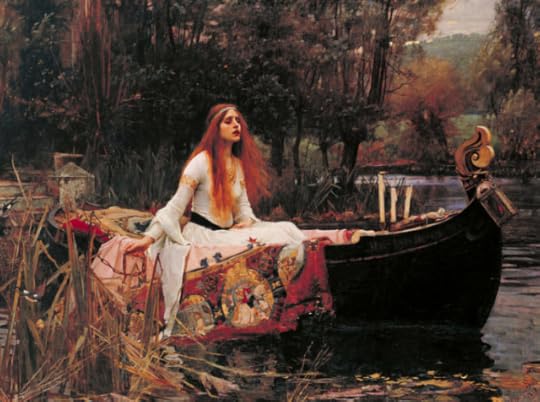 The Lady of Shalott by John William Waterhouse,1880 ~ note the girdle around her waist ~ Wikipedia
The Lady of Shalott by John William Waterhouse,1880 ~ note the girdle around her waist ~ WikipediaThe following day Gawain, with a pounding heart and the girdle wrapped around his waist, set out to meet the Green Knight. He found the giant sharpening his blade outside of the Chapel.
"So you have come?" The Green Knight stated with a look of surprise.
"I accepted the challenge," Gawain stated with a bravery he was not feeling.
"The kneel and place your neck upon the blog, young Knight of Camelot."
Gawain closed his eyes briefly and prayed to God for courage. He knelt and bared his neck. The Green Knight raised his axe. And despite himself, Gawain flinched in fear.
"I should have known," The Green Knight jeered. "You are a coward, and you bring shame to your King."
"Swing again," Gawain growled, "And I will not flinch."
The Green Knight raised his axe and feigned a strike.
"Be done with it," Gawain ordered. "Do not tease."
"I was merely testing your resolve," the Green Knight stated.
The Green Knights raised his axe again, and Gawain closed his eyes. The blade cut through the air, but instead of taking his head it only scratched his skin, although it drew blood.
"That was for the lie you told me, for you are wearing my wife's girdle. Rise, Sir Knight," the Giant stated. "The challenge is over."
With unsteady legs, Gawain rose to his feet and turned to look at the Giant, but the Giant was not there. In his place was his kind host, Bertilak.
"What is this?" Gawain asked, thoroughly confused.
"A test, young knight, from Arthur's sister. She thought you would fail. I am pleased to say you passed, for you are indeed chivalrous, brave, and for the most part... Honest."
Sir Gawain and Sir Bertilak parted on good terms. When Gawain finally made it home from Camelot, he was greeted with a hero's welcome. And from that day on the Knights of Camelot wore a green sash around their waist in recognition of Gawain's quest and a reminded to always be honest.
Copyright © 2017 Mary Anne YardeFirst Published on Our Author Gang (December 2017)
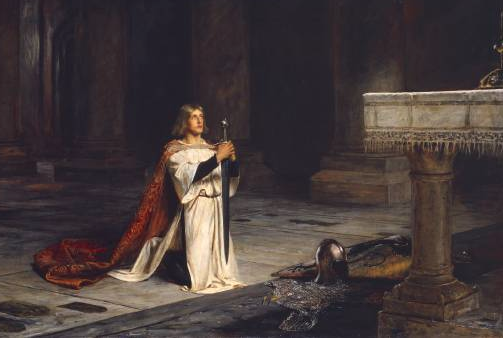 The Vigil by John Pettie, 1888 ~ Gawain represented the perfect knight, as a fighter, a lover, and a religious devotee ~ Wikipedia
The Vigil by John Pettie, 1888 ~ Gawain represented the perfect knight, as a fighter, a lover, and a religious devotee ~ WikipediaIt beats a game of Cluedo and Guess Who? I suppose. Although, I think I will celebrate Christmas and see in the New Year with a couple of board games and a verse of Auld Lang Syne.
The Du Lac Prophecy
(Book 4 of The Du Lac Chronicles)
Two Prophesies. Two Noble Households. One Throne.
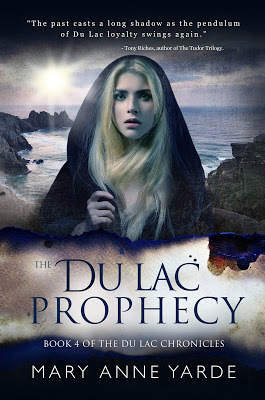 Distrust and greed threaten to destroy the House of du Lac. Mordred Pendragon strengthens his hold on Brittany and the surrounding kingdoms while Alan, Mordred’s cousin, embarks on a desperate quest to find Arthur’s lost knights. Without the knights and the relics they hold in trust, they cannot defeat Arthur’s only son – but finding the knights is only half of the battle. Convincing them to fight on the side of the Du Lac’s, their sworn enemy, will not be easy.
Distrust and greed threaten to destroy the House of du Lac. Mordred Pendragon strengthens his hold on Brittany and the surrounding kingdoms while Alan, Mordred’s cousin, embarks on a desperate quest to find Arthur’s lost knights. Without the knights and the relics they hold in trust, they cannot defeat Arthur’s only son – but finding the knights is only half of the battle. Convincing them to fight on the side of the Du Lac’s, their sworn enemy, will not be easy.If Alden, King of Cerniw, cannot bring unity there will be no need for Arthur’s knights. With Budic threatening to invade Alden’s Kingdom, Merton putting love before duty, and Garren disappearing to goodness knows where, what hope does Alden have? If Alden cannot get his House in order, Mordred will destroy them all.
Amazon

Mary Anne Yarde
 Mary Anne Yarde is the multi award-winning author of the International Bestselling series — The Du Lac Chronicles.
Mary Anne Yarde is the multi award-winning author of the International Bestselling series — The Du Lac Chronicles.Yarde grew up in the southwest of England, surrounded and influenced by centuries of history and mythology. Glastonbury — the fabled Isle of Avalon — was a mere fifteen-minute drive from her home, and tales of King Arthur and his knights were a part of her childhood.
Mary Anne loves to hear from readers, you can find her:
Media Links: Website/Blog • Facebook • Twitter • Amazon Author Page • Goodreads
Published on December 06, 2018 23:00
December 5, 2018
A Victorian Christmas, by Trisha Hughes #Victorian #Christmas #History @TrishaHughes_

A Victorian ChristmasBy Trisha Hughes
No era in history has influenced the way in which we celebrate Christmas quite as much as the Victorian era. Before Victoria’s reign began in 1837 nobody in Britain had heard of Santa Claus or Christmas Crackers. No Christmas cards were sent and most people did not have holidays from work. Instead, for thousands of years, people around the world had enjoyed midwinter festivals. Christmas was a time for fasts, vigils, prayers, and the giving of alms both to monasteries and to the common people, for the full twelve days before Christmas.
In Anglo-Saxon days, Christmas did not have the same importance in the church calendar as it does today. It was only the arrival of Christianity that pagan festivals became mixed with Christmas celebrations. Long before the birth of Christ, midwinter had always been a time for merry-making by the masses. The root of the midwinter rituals was the winter solstice – the shortest day – which falls on 21st December. After this date the days lengthened and the return of spring, the season of life, was eagerly anticipated. It was therefore a time to celebrate both the end of the autumn sowing and the fact that the ‘life giving’ sun had not deserted them. Bonfires were lit to help strengthen the ‘Unconquered Sun’. One of the leftovers from these pagan days is the custom of bedecking houses and churches with evergreen plants like mistletoe, holly and ivy. Apparently, as well as their magical connection in protecting us from evil spirits, they also encourage the return of spring.
With the wealth and technologies generated by the industrial revolution of the Victorian era, the face of Christmas changed forever. Authors like Charles Dickens wrote books like “Christmas Carol”, published on 17th December 1843, which actually encouraged rich Victorians to redistribute their wealth by giving money and gifts to the poor. Arguably this most famous story featuring Ebenezer Scrooge is said to have had the greatest impact on Christmas celebrations in the western world. The story’s focus on the triumph of good over evil and the importance of family brought a new meaning to Christmas in the Victorian era and established the modern interpretation of Christmas as a festive family gathering. These radical middle-class ideals eventually spread to the not-quite-so-poor as well.
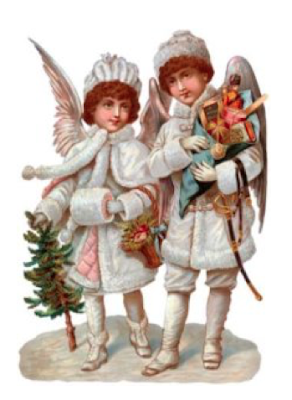
The wealth of the new factories and industries of the Victorian age allowed middle-class families in England and Wales to take time off work and celebrate over two days, Christmas Day and Boxing Day. Boxing Day, December 26th, earned its name as the day servants and working people opened the boxes in which they had collected gifts of money from the “rich folk”. The new-fangled invention, the railway, allowed the country folk who had moved into the towns and cities in search of work to return home for a family Christmas.
The Scots have always preferred to postpone the celebrations for a few days to welcome in the New Year in the style that is Hogmanay. And no one celebrates Hogmanay with such revelry and passion as the Scots. It is believed that many of the traditional Hogmanay celebrations were originally brought to Scotland by the invading Vikings in the early 8th and 9th centuries. These Norsemen, or men from an even more northerly latitude than Scotland, paid particular attention to the arrival of the Winter Solstice or the shortest day, and fully intended to celebrate its passing with some serious partying.
It may surprise many people to note that Christmas in Scotland, for around 400 years from the end of the 17th century to the 1950s, was not celebrated as a festival and virtually banned. The reason for this dates back to the years of Protestant Reformation, when the straight-laced Kirk proclaimed Christmas as a Popish or Catholic feast, and as such needed banning.
And so it was, right up until the 1950s that many Scots worked over Christmas and celebrated their winter solstice holiday at New Year when family and friends would gather for a party and to exchange presents which came to be known as Hogmanay. Christmas Day itself did not become a holiday in Scotland until many years after Victoria’s reign and it has only been within the last 20-30 years that this has been extended to include Boxing Day.
In Wales, the day after Christmas Day was celebrated in a way unique and included the tradition of “holly-beating” or “holming.” Young men and boys would beat the unprotected arms of young females with holly branches until they bled. In some areas it was the legs that were beaten. In others, it was the custom for the last person to get out of bed in the morning to be beaten with sprigs of holly. These customs died out before the end of the 19th century (luckily for young girls and those who like a lie-in!)
At the start of Victoria’s reign, children’s toys tended to be handmade and hence expensive, generally restricting availability to those “rich folk” again. With factories however came mass production, which brought with it games, dolls, books and clockwork toys all at a more affordable price. Affordable that is to “middle class” children. In a “poor child’s” Christmas stocking, which first became popular from around 1870, only an apple, orange and a few nuts could be found.
Normally associated with the bringer of the above gifts, is Father Christmas or Santa Claus. The two are in fact two entirely separate stories. Father Christmas was originally part of an old English midwinter festival, normally dressed in green, a sign of the returning spring. The stories of St. Nicholas (Sinter Klaas in Holland) came via Dutch settlers to America in the 17th Century. From the 1870’s Sinter Klass became known in Britain as Santa Claus and with him came his unique gift and toy distribution system – reindeer and sleigh.
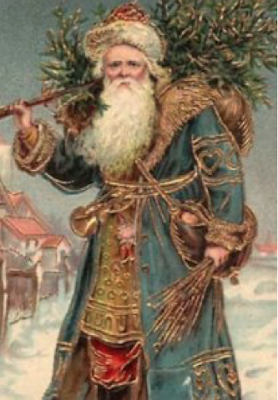
Christmas Cards – or the “Penny Post” - was first introduced in Britain in 1840 by Rowland Hill. The idea was simple, a penny stamp paid for the postage of a letter or card to anywhere in Britain. This simple idea paved the way for the sending of the first Christmas cards. Sir Henry Cole tested the water in 1843 by printing a thousand cards for sale in his art shop in London at one shilling each. The popularity of sending cards was helped along when in 1870 a halfpenny postage rate was introduced as a result of the efficiencies brought about by the new-fangled railways.
Before Victorian times, turkeys had been brought to Britain from America for hundreds of years. When Victoria first came to the throne however, both chicken and turkey were too expensive for most people to enjoy. In northern England roast beef was the traditional fayre for Christmas dinner while in London and the south, goose was favourite. Early on at the introduction of Christmas celebrations, many poor people had made do with rabbit but by the end of the century most people began feasting on turkey for their Christmas dinner. The great journey to London started for the turkey sometime in October. Feet clad in fashionable but hardwearing leather the unsuspecting birds would have set out on the 80-mile hike from the Norfolk farms. Arriving obviously a little tired and on the scrawny side they must have thought London hospitality unbeatable as they feasted and fattened on the last few weeks before Christmas. On the other hand, the Christmas Day menu for Queen Victoria and family in 1840 included both beef and of course a royal roast swan or two.
The original idea of the crackers, invented by Tom Smith, a London sweet maker in 1846, was to wrap his sweets in a twist of fancy coloured paper, but this developed, and sold much better, when he added love notes (motto’s), paper hats, small toys and made them go off with a BANG.
Queen Victoria’s German husband Prince Albert helped to make the Christmas tree as popular in Britain as they were in his native Germany, when he brought one to Windsor Castle in the 1840’s. Usually Windsor Castle came into its own at Christmas.
Vikings to Virgin
The Hazards of Being King
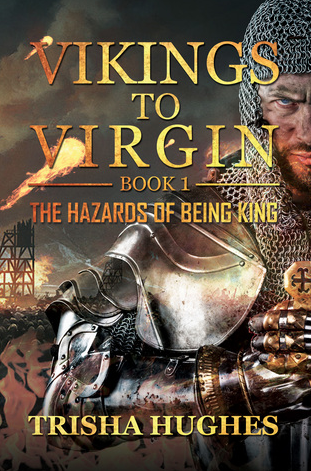
In Vikings to Virgin - The Hazards of Being King Trisha Hughes provides the reader with a pacey introduction to the many pitfalls faced by the ambitious as they climbed the dangerous ladders of royalty. It is easy to think that monarchs are all powerful, but throughout the Dark and Middle Ages it was surprisingly easy to unseat one and assume the crown yourself. But if it was easy to gain ... it was just as easy to lose.From the dawn of the Vikings through to Elizabeth I, Trisha Hughes follows the violent struggles for power and the many brutal methods employed to wrest it and keep hold of it. Murder, deceit, treachery, lust and betrayal were just a few of the methods used to try and win the crown. Vikings to Virgin - The Hazards of Being King spans fifteen hundred years and is a highly accessible and enjoyable ride through the dark side of early British monarchy.
Virgin to Victoria
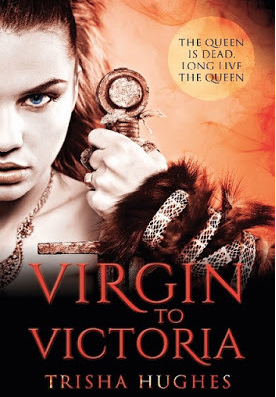
Virgin to Victoria is a powerful retelling of the history of the British monarchy, beginning with Henry VIII's daughter, Elizabeth I, as she comes to the throne. Charting Elizabeth's incredible journey, Virgin to Victoria travels in time through the confusion of the Stuart dynasty, the devastation of a Civil War led by Oliver Cromwell, horrific battles for the throne and the turbulent Hanover dynasty with its intricate family squabbles. Despite her amazing legacy, Elizabeth failed England in one vital area. She never married, nor did she leave an heir to the Tudor family. In making this one fateful decision, the Virgin Queen left the path open for a take-over and life would never be the same. Victoria did not ask to be Queen. It was thrust upon her by a series of events that removed all others who stood in line for the throne. She assumed it reluctantly and, at first, incompetently. Parliament was sure that the 18-year-old could be relied upon to leave the job of running the country to the professionals. Couldn't she?
Amazon UK • Amazon US
Trisha Hughes
 I was born in a little outback town called Blackall in Central Queensland, Australia. From there my parents moved to the Brisbane suburb of Fortitude Valley where I grew up to be a tiny, self-reliant little girl.
I was born in a little outback town called Blackall in Central Queensland, Australia. From there my parents moved to the Brisbane suburb of Fortitude Valley where I grew up to be a tiny, self-reliant little girl.My first book, ‘Daughters of Nazareth’ is my story, written eighteen years ago, fuelled on by the discovery of a family I never knew I had. It’s full of family secrets, tremendous heartache but proves the human spirit’s amazing ability to triumph over adversity. Nineteen years ago, after just one phone call, my life changed abruptly. With that change came a passion for writing and I have been writing ever since.
I love writing crime novels but my passion is with the history of the British Monarchy. The first in my ‘V2V’ trilogy is ‘Vikings to Virgin – The Hazards of being King ’ published in 2017. The second in the series is due for release on 28th April this year and is called ‘Virgin to Victoria – The Queen is Dead. Long live the Queen.’ The final book, ‘Victoria to Vikings – The Circle of Blood’ will be released early 2019.
Published on December 05, 2018 23:00
December 4, 2018
Christmas in the time of King Olof – or how to hedge your bets, by Anna Belfrage #Christmas #History @abelfrageauthor
 Christmas in the time of King Olof – or how to hedge your bets.By Anna Belfrage
Christmas in the time of King Olof – or how to hedge your bets.By Anna BelfrageAccording to tradition, baby Jesus was born on the night between December 24 and December 25, exactly nine months after the Virgin Mary had a visit from the Angel Gabriel who announced she was to conceive and give birth to the son of God. Leaving aside the issue of whether or not Jesus was, indeed, divine, these days there seems to be a consensus that Jesus was not born in December. Far more probable is that he was born late September which means he was conceived around Christmas, not born then.
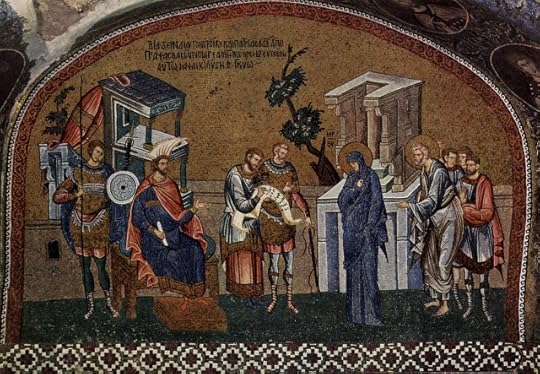
I dare say we will never know for sure. It’s not as if we will suddenly find detailed records stating a baby boy was born to one Mary in a stable at Bethlehem. The men who wrote the gospels were far more focused on telling a good story than they were on corroborating the facts around Jesus’ birth – to them, it was the adult man, the inspired prophet and martyr, who inspired their love and devotion. Giving Jesus a childhood, a birthday was all part of the backstory. As all authors know, the backstory has to be plausible—but it is not central to the narrative, ergo don’t get stuck in writing it.
Christianity did not burst upon the world like a wild fire, consuming (converting) everyone in its way. No, Christianity started out as a subversive religion. In the Roman Empire, the god to worship was the sitting emperor. Things generally did not work out for you if you chose to worship Christ instead.
However, something in the overall message of Christianity must have appealed and by the 4th century it had become the official religion of the Roman Empire. Over the coming centuries, diligent apostles travelled the known world, spreading the word of God.
Being a most pragmatic organisation, the Holy Church made conversion more appealing to all the wild pagans that inhabited the then known world by syncing the traditional holidays with the new Christian festivities. The ancient feast of Samhain became All Hallows. Midsummer Eve became the feast of St John the Baptist. And the ancient festivities that surrounded the midwinter solstice became Christmas, with baby Jesus given an adequate birthday in this the darkest period of the year (up in the Northern Hemisphere) Most apt, the fathers of the Church, thought: an infant to spread a ray of hope when things were at their darkest.
Obviously, this approach was successful. Soon, most of Europe had embraced the Christian faith. And one day, the apostles made it all the way to Scandinavia…
In the early 11th century, the Swedish king Olof Skötkonung converted, inspired to do so by Sigfrid from England. As all kings of the period, Olof was expected his subjects to embrace his new faith. He was, however, somewhat wary of annoying the Norse gods—or more specifically those of his subjects who still clung to the old traditions. After all, kings back then were elected, and an unpopular king could well find himself out on his ear. Not a fate Olof aspired to.
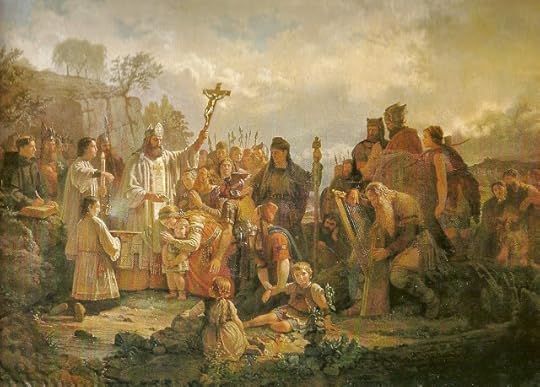
So here we are: the year is around 1010 and recently baptised Ingvar and his wife Gunnel are about to begin celebrating the festive season. It is cold. Outside, the lake Mälaren is covered with ice that crackles underfoot. The little town of Sigtuna is an affluent place, strategically situated within the protective embrace of the lake but close to the Baltic Sea. Along the shore, the richer inhabitants have lots that extend from the main street to the lake shore. At one end a house, at the other a wooden wall with a barred gate that leads to a pier and the moored boat. In between, some sheds. And from one of those sheds comes a high-pitched squeal that ends with a gurgle...
“Ah,” said Ingvar to his eldest son. “The pig is dead.”“Do pigs go to heaven?” Ragnar asked.Ingvar had no idea. “Särimer does,” he said, ruffling Ragnar’s flaxen hair. “Every night, the fallen warriors feast on him, every day he is reborn, as good as new.”Ragnar gave him a doubtful look. “Father Ansgar says such talk is heathen talk and that neither Valhalla nor Särimer exist.”Ingvar nodded, no more. The priest was annoyingly insistent when it came to this. “No one knows,” he said. “After all, no one has ever returned from the shadowed valley of death.”Ragnar chewed his lip, his gaze affixed on his mother, now emerging from the slaughter-shed, her bloody hands having left equally bloody imprints on her apron. She was followed by one of the thralls, carrying a steaming bowl full of blood. Ingvar’s gaze lingered on Gunnel. Even in her homespun brown and her everyday bronze buckles keeping her dress in place, she was a sight for sore eyes, her thick braid snaking down her back from under the clout covering her head. “A quick death,” Gunnel said. “This year, we will feast on ham sausages and ribs at the midwinter feast.” There was a streak of blood on her forehead, and a sudden ray of winter sun set her pale blue eyes sparkling. Ingvar was proud of his wife, a striking woman who managed their home, their lands, their wares—even him—with a firm hand. “The Christ Mass, you mean,” he corrected, sharing a quick grin with her.“Yes, of course.” Gunnel gestured for the thrall to hurry off to the cook house. “First, we spend hours in the cold church, then we feast.”Ingvar moved closer. “But before we do that, we will do as our forefathers have done.”“Ingvar!” Gunnel hissed. “You know that is dangerous. Ansgar has made it quite clear he will not tolerate such behaviour.”“And here was I thinking it was Olof who was the king,” Ingvar muttered. “Never fear, my little cockle-shell, I will be careful.” Gunnel sighed. “Ragnar does not go with you.”“No, of course not,” Ingvar muttered, but behind Gunnel’s back he winked at his son. Ragnar would soon be a man and needed to know a thing or two about the faith of his forefathers. Ingvar may have submitted to that ridiculous christening ceremony but in his heart he still retained doubts: the gods of his father and grandfather were powerful creatures, complete with vices and virtues, while this White Christ was at most virtuous—and far too meek.
It was gone midnight a week or so later when Ingvar slipped out through the water gate, balancing along the precarious track that bordered the shoreline. In his hand was a squirming sack, and behind him Ragnar trotted to keep up, keeping a firm hold on Ingvar’s cloak.
They didn’t speak, moving silently through the sleeping settlement. Other men joined them, like wraiths they made their way towards the woods. Frost crackled underfoot. The moon was half-full, the night so clear and cold every gust of breath sparkled in the moonlight. Once under the trees, Ingvar and his companions relaxed. Big Björn unslung the hogtied goat from around his shoulders and had the beast trotting along beside him instead. Someone produced mead, and the skin was passed back and forth as they clambered up the steep slope towards the blot-tree.
“Old like the hills,” Ingvar told Ragnar. “When my grandfather was a boy, it was as big as it is now, and he always said his grandfather remembered it as being just as huge when he was a child.” Ragnar nodded no more, craning his head back to take in the spreading branches of the ancient oak. “Is it true that sometimes men were sacrificed as well?”
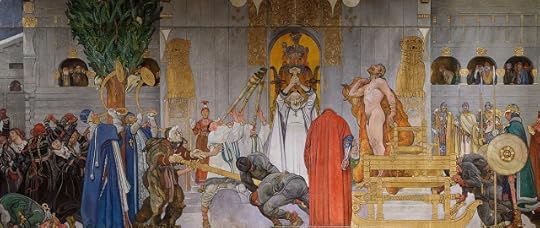
“It is,” Björn replied. “When times were dire, the gods required more than their standard fare. At times, it was the king who willingly gave his life that others may live.”Ragnar moved closer to Ingvar. “Would Olof do that?”“King Olof to you, lad,” Ingvar corrected. “Aye, he is our cousin, but he is first and foremost your king.”“Olof doesn’t believe in the old gods anymore,” Björn said. “And you do?” Ragnar asked.“Better safe than sorry,” Ulf replied. Gunnel’s tall brother grinned at Ragnar. “Ready?”They began with a cockerel. A quick death, and the bird was soon adorning one of the branches, its blood spattering the snow beneath. Next came Ingvar’s half-grown kitten. “Father!” Ragnar gasped. “That’s Ingrid’s cat.” “Not anymore. Now it belongs to the gods,” Ingvar grimaced at the thought of how upset his daughter would be, but some things were more important than others. A quick slicing movement and the cat was hoisted up to hang upside down as it bled out. Ragnar backed away, his eyes large and black in the moonlight. “I want to go home.” “Too late for that. Have some mead,” Björn said, handing Ragnar the skin. He patted the boy on his head. “Your father took you for braver than you are, hey?”Ragnar didn’t reply, his gaze locked on the next sacrifice, a rabbit. One by one, the various male animals were hung up, their throats slit. One by one, they died. Beneath the tree, the snow had darkened and the men stood in a circle around it.“To Tor,” Björn announced, lifting his fisted hand towards the moon. “To Oden, All-father.”“To Oden,” the other men repeated. “And now, we must make haste,” Ulf said. “It is close to midnight, and Ansgar will be standing at the church door to count his flock.”Some of the men snickered. Ragnar slipped his mittened hand into Ingvar’s. “What would Ansgar do if he found out?” the boy whispered.“Nothing. What can he do?”“Have you whipped for heresy?” a voice rang out from somewhere to their right. Out into the moonlit clearing strode Olof, looking anything but pleased. “Or maybe I should do it,” he added, throwing a look at the blot-tree. “You could try,” Björn said. “Try, and my kinsmen will make you pay.” Olof rolled his eyes. “Barbarians, the lot of you.” Then he grinned and held up a duck. “Best hedge your bets, I say.” His face fell. ”Don’t tell Estrid,” he muttered. “My dear wife is much taken with this new religion.”“Tell Estrid?” Ulf snorted. “Your foreigner wife prefers to pretend we do not exist, uneducated riff-raff that she thinks us.” “Like me,” Olof said, handing over the duck to Björn. Moments later, yet another animal swung from the tree.
They arrived warm and sweaty just as Ansgar was about to close the door. The priest scowled, caught sight of the king and rearranged his features into a frown. “You are late, my lord,” was all he said as he stood aside to let the king pass. Ingvar entered last, holding Ragnar’s hand. Ansgar stepped forward, thereby crowding Ingvar against the rough stone wall. “I know what you’ve been doing,” the priest hissed, entirely unaffected by the fact that Ingvar was well over a head taller and likely twice as strong. “One day, you’ll burn for it. If not in this world, then the next.”Ingvar shrugged. But as he stood beside his wife and children, he clasped his hands together and prayed fervently to White Christ. Just in case.
***
A Torch in His Heart (The Wanderer Book 1)
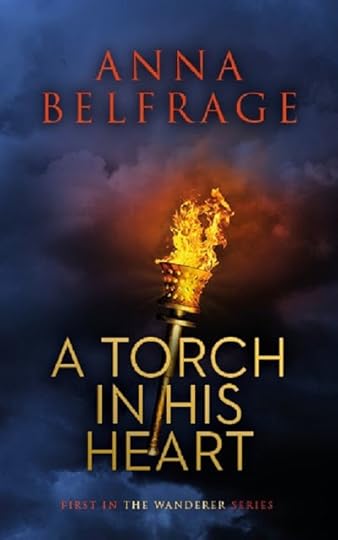
In the long lost ancient past, two men fought over the girl with eyes like the Bosporus under a summer sky. It ended badly. She died. They died.
Since then, they have all tumbled through time, reborn over and over again. Now they are all here, in the same place, the same time and what began so long ago must finally come to an end.
Ask Helle Madsen what she thinks about reincarnation and she’ll laugh in your face. Besides, Helle has other stuff to handle, what with her new, exciting job in London and her drop-dead but seriously sinister boss, Sam Woolf. And then one day Jason Morris walks into her life and despite never having clapped eyes on him before, she recognises him immediately. Very weird. Even more weird is the fact that Sam and Jason clearly hate each other’s guts. Helle’s life is about to become extremely complicated and far too exciting.
Amazon UK • Amazon US
Anna Belfrage
 Had Anna been allowed to choose, she’d have become a time-traveller. As this was impossible, she became a financial professional with two absorbing interests: history and writing. Anna has authored the acclaimed time travelling series The Graham Saga, set in 17th century Scotland and Maryland, as well as the equally acclaimed medieval series The King’s Greatest Enemy which is set in 14thcentury England. She has recently released the first in a new series, The Wanderer. This time, she steps out of her normal historical context and A Torch in His Heart is with a fast-paced contemporary romantic suspense with paranormal and time-slip ingredients. Find out more about Anna by visiting her website, or her Amazon page. If you want to read more about Vikings, God and St Sigfrid, read Anna’s post “Bringing God to the Vikings.”
Had Anna been allowed to choose, she’d have become a time-traveller. As this was impossible, she became a financial professional with two absorbing interests: history and writing. Anna has authored the acclaimed time travelling series The Graham Saga, set in 17th century Scotland and Maryland, as well as the equally acclaimed medieval series The King’s Greatest Enemy which is set in 14thcentury England. She has recently released the first in a new series, The Wanderer. This time, she steps out of her normal historical context and A Torch in His Heart is with a fast-paced contemporary romantic suspense with paranormal and time-slip ingredients. Find out more about Anna by visiting her website, or her Amazon page. If you want to read more about Vikings, God and St Sigfrid, read Anna’s post “Bringing God to the Vikings.” Anna would also like to point out that there is some disagreement as to when the midwinter blot usually took place. Some say it happened in December, some say mid-January.
Published on December 04, 2018 23:00
December 3, 2018
Christmas in the time of Richard III, by Alex Marchant #Christmas #Medieval #RichardIII @AlexMarchant84

Christmas in the time of Richard III
By Alex Marchant
King Richard III spent such a brief time on the throne that it can be difficult to separate out his reign from those of the kings before and after him. In terms of typical celebrations in the 1480s, this ‘Christmas in the time of ....’ could be as much about festivities under his predecessor Edward IV or Henry VII. However, some details about the way Richard himself kept the Christmas season have come down to us through the centuries. This is particularly the case with his final Christmas, that of 1484, owing to the waspish words of a chronicler, who was likely writing some time after Richard’s defeat at Bosworth ... and taking the opportunity to view that time in hindsight and make the dead king’s actions blameworthy for what would come later.
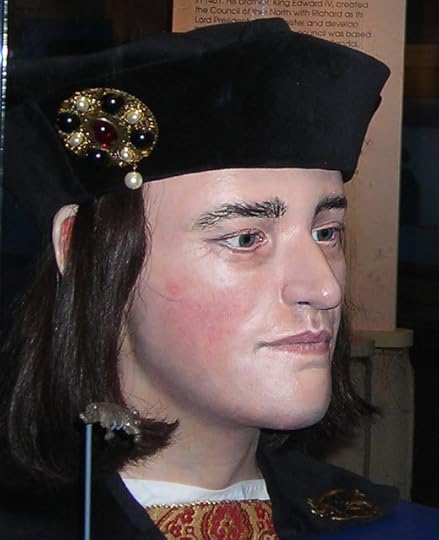 Reconstruction of the head of King Richard III
Reconstruction of the head of King Richard IIIRichard reigned only two years and two months, and so in that time celebrated only two Yuletides. The previous Christmas, 1482, it seems he spent in London, perhaps at his brother Edward IV’s court, as Parliament was called for the middle of January and Richard is known to have purchased gifts from a London goldsmith during the festive period. The following months wrought great changes in his life, and that of many around him, as his brother died unexpectedly, Richard became Protector of the realm, his nephew – the new king Edward V – was declared illegitimate owing to his parents’ bigamous marriage, and Richard then was offered, and accepted, the throne as the next legitimate heir. Autumn 1483 brought rebellion against the new king – by Lancastrians presumably seeing the upheaval as a chance to try again for the throne – but it was relatively easily quashed and King Richard returned to his capital in triumph, just in time for Advent. The scene was set for a magnificent Christmas at the new court.
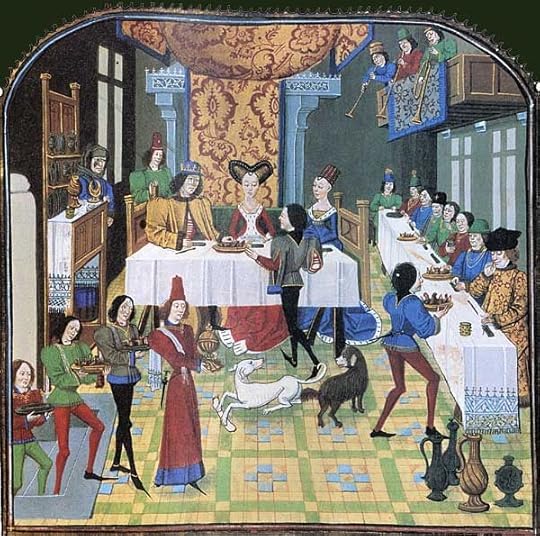 Histoire d’Olivier de Castile
Histoire d’Olivier de CastileThere is some evidence that Richard’s finances were precarious in the early part of his reign, owing to difficulties in securing his brother’s treasury during the Protectorate, and then the expenses of gathering and equipping the army to put down the rebellion. But his relations with the wealthy merchants of London and elsewhere were always amicable, especially after the various favourable laws he enacted in his only Parliament, and they were happy to advance money on various royal treasures, such as a gold and jewel-encrusted salt cellar and a helmet embellished with gold, gems and pearls, in order to fund the festivities. A bill to the enormous sum of £1,200 was run up with a mercer, no doubt to supply sumptuous gowns, outfits and gifts for the king, queen and courtiers, and Richard likely treated his wife, Anne, to the finest jewels, having earlier in the month licensed a Genoese merchant to import precious gems, so long as he himself was given first option to buy.
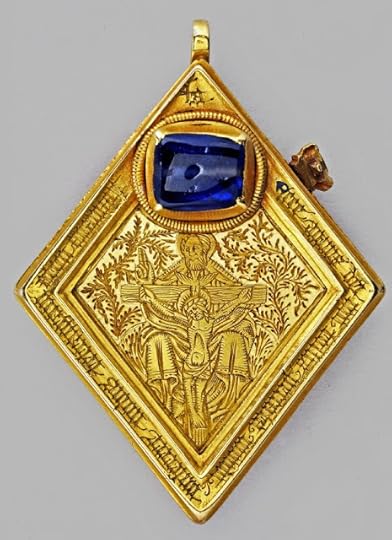 The Middleham jewel: might it have been made for Queen Anne, perhaps as a Yuletide gift?
The Middleham jewel: might it have been made for Queen Anne, perhaps as a Yuletide gift?The following year, 1484, again brought tragedy for Richard’s family with the death of his only legitimate son and heir, little Edward of Middleham, in the spring. But in December, as the twelve days of Christmas began, it was again time for the conspicuous consumption that was required of a king. The court must impress with lavish feasting, gifts, entertainments, largesse, charitable donations, a display that would show all was well in the kingdom – whatever personal tragedy might befall its premier family, or whatever threat might be lurking abroad. For it is said that King Richard was brought news of Henry Tudor’s planned invasion during the Twelfth Night festivities – although that might be that devious chronicler juxtaposing unrelated events once again for his own purposes.That chronicler, writing a year or two later at Crowland abbey in Lincolnshire, was also at it – as mentioned earlier – when deploring the opulent nature of the festivities. As so often happens with Edward IV, he let the previous king’s magnificent, even excessive celebrations a few years before have a bye, but Richard must be castigated – now that Henry Tudor has become king! He laments the expense, the splendour, even the quantity of singing and dancing (perhaps it was too much for a cleric) at the Yuletide court – but in particular he targets the ‘vain changes of dress – similar in colour and design’ of Queen Anne and her niece, Elizabeth of York, illegitimate daughter of the old king, saying ‘At this people began to talk, and the lords and prelates were horrified.’ His aim appears to be to link this with the later rumour that surfaced after Queen Anne’s tragic death the following spring, that Richard was considering marrying his niece – and may even have been responsible for his wife’s death – in the same way as he also appears to suggest little Edward’s death was somehow retribution for Richard’s earlier ‘crimes’.
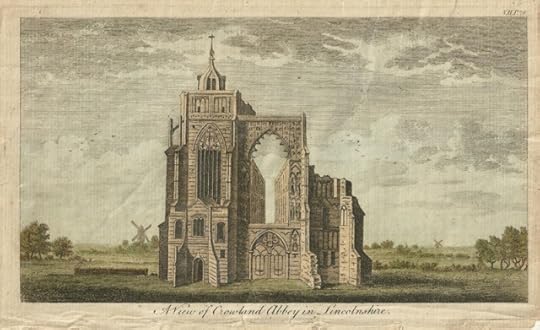 Crowland Abbey
Crowland AbbeyYet in truth it had long been a tradition in medieval courts, both in England and elsewhere, that the entire household would dress in the same colour on certain feast days: during the lengthy Christmas revelries, they might alternate colours on different days, with the ladies wearing colours to complement the men’s outfits (which may have led to the enormous mercer’s bill mentioned above). And Richard had pledged to ensure Elizabeth married well, despite her illegitimacy, and by the spring was in negotiations for her to wed Duke Manuel of Beja, later King Manuel I of Portugal.In my own novel for children, The King’s Man, telling the story of Richard’s ascent to the throne and his all-too-brief reign, my leading protagonist, Matthew, is kept abreast of events at court by letters from his good friend, Alys, which are ‘full of the colour and finery of the royal festivities’. And her words about the King and Queen fill him ‘with the good cheer suitable to the Christmas season’:During Christmas they have looked happier than I had seen them for months, at least since that terrible time in the spring. The Queen and Elizabeth and all the ladies have been wearing the most sumptuous gowns of cream and gold, while the gentlemen have dressed mostly in blues and greys. But on Twelfth Night – what a spectacle! We were all clad in red or gold, like flames in the great fireplaces of the palace. The Queen had made a gift to Elizabeth of a gown exactly like her own, and the King had presented them both with the most beautiful jewels. He then led both of them out to dance while everyone cheered and clapped.One last moment of pleasure, maybe, before the dire events of the coming months. But, as always seems to be the case with Richard, everything must be viewed by Tudor sources and the later historians that follow them in the light of what later transpired, and must be related back to the crimes that this most maligned of kings is alleged to have committed. However, I prefer to think that perhaps Christmas 1484 offered this royal couple a brief glimmer of light, hope even, in an otherwise grim year.
***
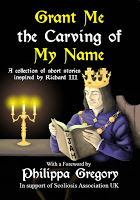
The Order of the White Boar, with its sequel, The King’s Man, the ideal stocking fillers for young (and not so young) historical fiction fans. King Richard looks on with approval!Also available Grant Me the Carving of My Name, an anthology of short fiction by authors inspired by Richard III, sold in support of Scoliosis Association UK (SAUK), order your copy HERE!
The Order of the White Boar
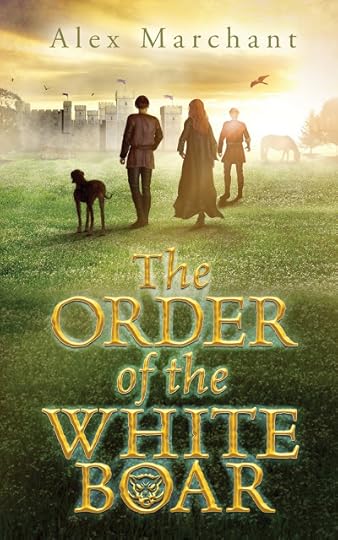
How well do you know the story of King Richard III? Not as well as Matthew Wansford.
Twelve-year-old Matthew Wansford has always longed to be a knight. And his chance comes in the golden summer of 1482 when he arrives at Middleham Castle, to serve the King’s brother, Richard, Duke of Gloucester.Soon he encounters a dangerous enemy. Hugh, a fellow page, is a better swordsman, horseman, more skilled in all the knightly arts – and the son of an executed traitor. Now he aims to make Matt's life hell.Yet Matt also finds the most steadfast of friends – Alys, Roger and Edward, the Duke’s only son. Together they forge a secret knightly fellowship, the Order of the White Boar, and swear an oath of lifelong loyalty – to each other and to their good lord, Duke Richard.But these are not times to play at war. Soon Matt and his friends will be plunged into the deadly games of the Wars of the Roses. Will their loyalty be tested as the storm looms on the horizon?
Amazon • Blurb
The King’s Men
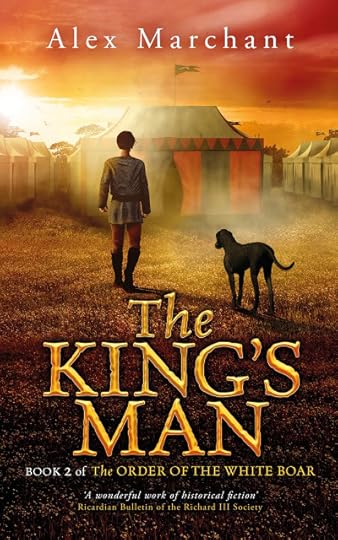
“These are dangerous days, Master Wansford, dangerous days.”The death of his brother King Edward IV has turned the life of Richard, Duke of Gloucester upside down, and with it that of his 13-year-old page Matthew Wansford. Banished from Middleham Castle and his friends, Matt must make a new life for himself alone in London. But danger and intrigue lie in wait on the road as he rides south with Duke Richard to meet the new boy king, Edward V – and new challenges and old enemies confront them in the city. As the Year of the Three Kings unfolds – and plots, rebellions, rumours, death and battles come fast one upon the other – Matt must decide where his loyalties lie. What will the future bring for him, his friends and his much-loved master? And can Matt and the Order of the White Boar heed their King’s call on the day of his greatest need?
Amazon • Blurb
Alex Marchant
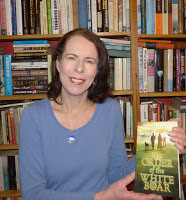 Born and raised in the rolling Surrey downs, and following stints as an archaeologist and in publishing in London and Gloucester, Alex now lives surrounded by moors in King Richard III’s northern heartland, working as a freelance copyeditor, proofreader and, more recently, independent author of books for children aged 10+.
Born and raised in the rolling Surrey downs, and following stints as an archaeologist and in publishing in London and Gloucester, Alex now lives surrounded by moors in King Richard III’s northern heartland, working as a freelance copyeditor, proofreader and, more recently, independent author of books for children aged 10+. Connect with Alex: Blog • Facebook • Twitter
Published on December 03, 2018 23:00
December 2, 2018
Christmas in the Time of King Henry VII: What do the records tell us? By Tony Riches, author of the Tudor Trilogy #Christmas #History #Tudors @tonyriches
 Christmas in the Time of King Henry VII: What do the records tell us?By Tony Riches, Author of the Tudor Trilogy
Christmas in the Time of King Henry VII: What do the records tell us?By Tony Riches, Author of the Tudor Trilogy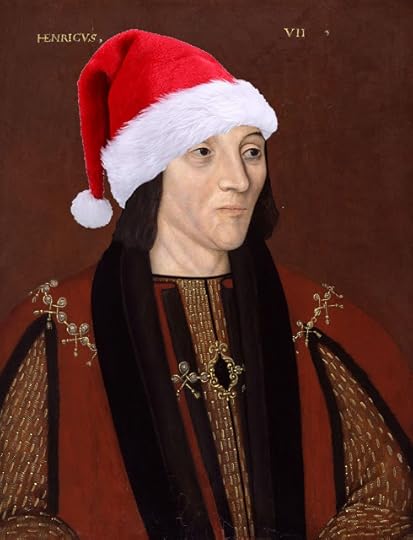
Henry Tudor has been described as ‘miserly’ by those who don’t know better, but surviving records show that he spent a small fortune on entertainments at the court, mainly around the twelve days of Christmas, New Year and Twelfth Night. Christmas day marked the end of a month of fasting and became a blend of religious celebration and merry-making.
Although there are few eye-witness accounts of Henry Tudor‘s celebrations, we know from the writs issued under the Privy Seal that as early as 1486, one year into Henry’s reign, Richard Pudsey, serjeant of the king's cellar, was paid a generous forty pounds for the preparation of a ‘disguising’ for Twelfth Night.
These ‘disguisings’ were performances by mummers and professional actors wearing masks and taking part in elaborately planned and choreographed entertainments. Over the course of Henry’s reign, these entertainments began to involve dramatic special effects and amazing scenery. They would typically aim to glorify the king and court – and included plenty of audience participation.
Court records also mention the Christmas celebrations for 1487/8, which describe a ‘goodly disgysyng’ on the evening of New Year's Day and that ‘also this Christmass ther wer many and dyvers playes’. The entertainments continued at the Twelfth Night banquet when the king’s minstrels played and the Gentlemen of the Chapel sang carols.
Disguisings and plays became common features of the Christmas celebrations. In the account of Christmas 1489 the herald notes that there was sickness abroad and, ‘This Christmass I saw no Disgysyngs, and but right few Pleys, but ther was an Abbot of Misrule that made muche Sport, and did right well his Office.’
The ‘Abbot’ or, as he was often called, ‘Lord of Misrule’ oversaw masques and ‘interludes’, such as poetry readings and amusing antics of the court fools. It was a well-paid job, as the records of Christmas 1491/2 show payment to a man named Ringley of a hundred shillings as ‘Lord of Misrule’ and the same again the following year as ‘Abbot of Misreule’.
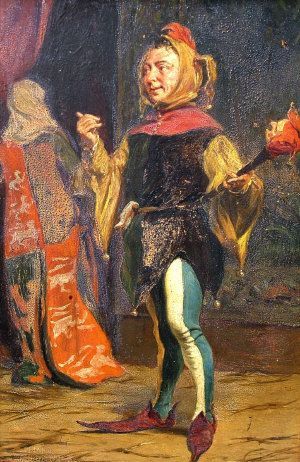
In November 1493 Walter Alwyn received sums totalling twenty nine pounds for the Christmas revels and disguising, and there is an account in the Great Chronicle of London of the revels for Twelfth Night 1494. The performance began with a ‘goodly interlude’, interrupted by the dramatic appearance of Master William Cornish, ‘apparaylid afftyr the fygure of Seynt George’, followed by a young girl dressed as a princess who led a fire-breathing dragon through the hall. Cornish led the Chapel in an anthem ‘off SeyntGeorge’ " then made his exit with the dragon.
These records provided the source for this short extract from Henry ~ Book Three of the Tudor Trilogy:
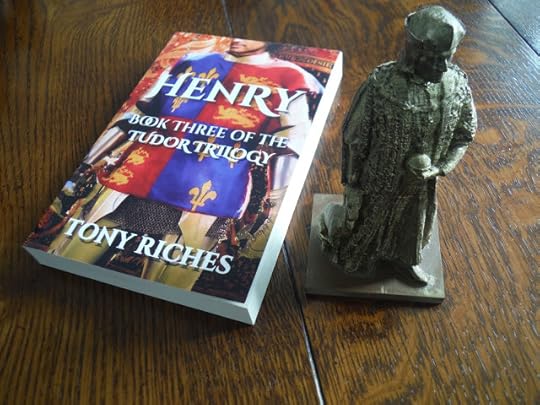
January 1493
Christmas at Westminster Palace was marked by a nativity feast of fat geese, painted with saffron butter to give them a golden glow. A private family occasion, a choir sang to the accompaniment of musicians with lutes and dulcimers, as well as Henry’s precious new clavichord, paid for from his own purse.
To Henry’s left sat his son Arthur, then his mother, Lady Margaret and her white-bearded husband, Sir Thomas Stanley. Beside him sat Sir Jasper, with his beautiful young wife Catherine Woodville. At the side of the queen sat her sisters, Lady Anne and Lady Catherine, both yet to be found suitable husbands.
The great yule boar, carried by four men to a fanfare of trumpets, seemed to snarl at them with gilded tusks and glittering diamonds for eyes. Henry’s kitchens excelled themselves with a nativity scene of sculpted sugar, complete with shepherds, wise men of the East and angels suspended overhead on fine silk thread.
Sir Jasper, as the elder of the Tudors, stood to propose the toast to peace and prosperity. He spoke of Christmases past, when Henry had been a child young Harry’s age, then in Brittany, where the late Duke Francis had shown them great kindness. He finally raised his goblet and dedicated the feast to the honour of her grace Lady Margaret, the king’s mother.
Later, at a midnight mass in the Royal Chapel of St Stephen, Henry knelt at the side of his mother and gave thanks to the Lord for his many blessings. He liked to make a new pledge before God with the dawn of each new year, and chose to honour the promise he’d made to himself to become a better father. His fears of losing his youngest daughter reminded him he’d become too preoccupied with matters of state.
His children were becoming strangers to him. It didn’t help that his family were dispersed over several palaces. Prince Arthur, now in his seventh year, had been hidden away with his tutors at Farnham in Hampshire. A thin-faced, serious boy, he’d hardly spoken to Henry since returning to London.
Their daughter Margaret, turned three the previous November, looked like a miniature version of Elizabeth, with a reddish tint to her golden hair and large, amber eyes, and seemed in awe of him. With little Harry, she’d been brought to Westminster from Eltham Palace. Once a hunting retreat and a favourite palace of King Henry IV, Eltham now served as the royal nursery.
Harry had the red hair of the Plantagenets and the build of his grandfather, Edward of York. Able to walk unaided much earlier than Arthur, he’d already learnt to run at every opportunity, a trial to his nursemaids. Henry was relieved that Arthur owed more to his Tudor heritage. He wondered how much work it might take to prepare his high-spirited second son for a life of devout contemplation in the church.
Elizabeth hardly ventured away from Sheen as she recuperated from the birth of their newest daughter. Little Elizabeth’s size and frailty had been a great worry to them both, yet at last she seemed to be thriving, thanks to the care and attention of her devoted wet-nurse, the likeable Lady Cecily Burbage, daughter of a neighbouring nobleman.
‘We shall mark the Twelfth Night as a family,’ Henry announced, ‘with music and singing, magic and disguisings!’
He placed his hand on Arthur’s shoulder. ‘I have a present for you, a fine new bow crafted from Spanish Yew. We’ll try it out at the butts tomorrow?’
‘Yes, Your Grace.’
‘Father.’ He corrected his shy son. ‘You must call me father.’ Henry studied his son’s thin, pale face and glimpsed an echo of himself at the same age. ‘You are growing into a fine scholar, Arthur,’ he grinned, ‘but we must make time for merrymaking. We shall spend more time together. I will teach you how to lose your money at cards!’
‘I should like that, Father.’ Arthur smiled, the first time Henry had seen him do so since he’d returned to Westminster.
Elizabeth picked up little Harry, already escaping on sturdy legs. ‘And you, sir, shall have sugar fancies.’
Harry’s bright eyes shone with affection for his mother, although he seemed not to even recognise his father. Henry produced a silver bell on a red silk ribbon from the pocket of his doublet. The shining bell tinkled musically as he dangled it in front of his youngest son.
‘A present for you, Harry!’
Strong little fingers grabbed the ribbon and Harry started swinging the silver bell so violently Elizabeth had to take it from him. He bawled in loud protest and she called to her ladies-in-waiting.
‘Fetch the minstrels to play, if you will.’ She smiled at Henry. ‘Music seems to calm him.’
‘As it does his father. Let there be music—and fools to cheer my son!’
Servants carried steaming cups of mulled wine for Henry and Elizabeth, as well as sweet treats for the children, who were brought low chairs and velvet cushions to sit on. A colourful satin curtain pulled back as if by magic, to reveal a candlelit wooden stage, with a canopy of state supported by long wooden poles, painted in spirals of Tudor green and white.
A musician beat his drum and the king’s trumpeters blasted a discordant note as Patch the fool appeared on the stage. Dressed as a knight, with a coat of knitted woollen mail and a cooking pot on his head, he began the entertainments as master of ceremonies, mimicking the arrogant tone of Sir John de Vere, Earl of Oxford, as he read from an over-large scroll.
He drew an enormous wooden sword, which he waved at the children while bellowing a humorous song of his great bravery. In a flash of smoke, another of Henry’s fools appeared. A stocky dwarf dressed as a bright red dragon, he did his best to avoid the oversized sword, roaring and dancing around Patch as Elizabeth’s minstrels played a lively jig. Little Harry clapped his hands in delight as the unconvincing dragon fell over his own tail and tripped from the stage.
Next came another of Henry’s fools, carrying a shepherd’s crook and wearing an absurdly high, gold-painted bishop’s mitre. Disguised as the Bishop of Misrule, he proceeded to wag his finger in the air and lecture the king and his family in a stentorian voice, yet none of his words made any sense.
‘He mocks Bishop Foxe!’ Elizabeth laughed.
‘A poor resemblance,’ Henry grinned, ‘yet his manner is unmistakable.’
A troupe of Flemish jugglers amazed them with their skill, throwing heavy wooden clubs to each other and spinning them high in the air. As the last of the jugglers vaulted from the stage, Patch the fool returned and bowed to Henry and Elizabeth with exaggerated reverence to announce the finale.
The choir of Westminster Cathedral entered, all dressed in white and wearing silver wings of angels. Their carolling echoed through the palace as they sang Henry’s favourite songs, accompanied by musicians with drums and flutes.
In January 1496 Ringley was paid forty shillings and in 1501 another payment of a hundred shillings to ‘Ryngesley for hym and his company’. More important than the ‘Abbot's’ pranks were the disguisings and plays presented at court for the Christmas revelry. There were often performances by professional companies and by the king's own players.
In 1501 there were several performances by the Gentlemen of the Chapel, the king's players and the prince's players, although there were no Twelfth Night disguisings. One reason might have been that King Henry was saving for the costly and extravagant wedding of his eldest son, Prince Arthur, in the autumn of that year.
Everything changed for Henry after the sudden death of his son at Ludlow Castle in 1502 and his wife Elizabeth of York the following year. No more ‘disguisings’ are mentioned in the accounts until Christmas 1507/8 when Master Wentworth made a ‘disguysing for a moryceDaunce’ and there is a Revels Account which shows that Wentworth was with preparing disguisings and pageants for the Flemish ambassadors to England in 1508/9.
King Henry VII died on the 21st April 1509 but his legacy was a Christmas tradition of merry making, music, elaborate fancy-dress masked balls, and parties. This was taken up with great enthusiasm by his son, the new young King Henry VIII, (who enjoyed taking part) as well as Queen Elizabeth I, which Queen Elizabeth II continues to this day!
Source: The Court Festivals Of Henry VII: A Study Based Upon The Account Booksof John Heron, Treasurer of The Chamber, By Sydney Anglo, B.A., Ph.D.
Tony Riches
 Tony Riches is a full-time UK author of best-selling historical fiction. He lives in Pembrokeshire, West Wales and is a specialist in the history of the Wars of the Roses and the lives of the early Tudors. For more information about Tony’s books please visit his website tonyriches.com and his popular blog, The Writing Desk and find him on Facebook and Twitter @tonyriches.
Tony Riches is a full-time UK author of best-selling historical fiction. He lives in Pembrokeshire, West Wales and is a specialist in the history of the Wars of the Roses and the lives of the early Tudors. For more information about Tony’s books please visit his website tonyriches.com and his popular blog, The Writing Desk and find him on Facebook and Twitter @tonyriches.
Published on December 02, 2018 23:00
November 30, 2018
Come and celebrate a Historical Christmas on Myths, Legends, Books & Coffee Pots... #Christmas #History
Have you ever wondered what Christmas was like in a bygone age?
This December there is a very magical Christmas theme on the blog. I have invited some of the finest authors in the historical fiction world to talk about
Christmas in the time of….

Check out the fabulous line-up for 2018!

3rd December
Tony Riches
 Tony Riches is a full-time UK author of best-selling historical fiction. He lives in Pembrokeshire, West Wales and is a specialist in the history of the Wars of the Roses and the lives of the early Tudors. For more information about Tony’s books please visit his website tonyriches.com and his popular blog, The Writing Desk and find him on Facebook and Twitter @tonyriches.
Tony Riches is a full-time UK author of best-selling historical fiction. He lives in Pembrokeshire, West Wales and is a specialist in the history of the Wars of the Roses and the lives of the early Tudors. For more information about Tony’s books please visit his website tonyriches.com and his popular blog, The Writing Desk and find him on Facebook and Twitter @tonyriches.
4th December
Alex Marchant
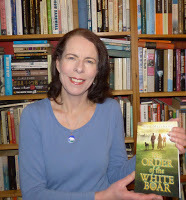 Born and raised in the rolling Surrey downs, and following stints as an archaeologist and in publishing in London and Gloucester, Alex now lives surrounded by moors in King Richard III’s northern heartland, working as a freelance copyeditor, proofreader and, more recently, independent author of books for children aged 10+.
Born and raised in the rolling Surrey downs, and following stints as an archaeologist and in publishing in London and Gloucester, Alex now lives surrounded by moors in King Richard III’s northern heartland, working as a freelance copyeditor, proofreader and, more recently, independent author of books for children aged 10+.Alex loves to hear from readers. You can find her: Blog • Twitter • Facebook

5th December
Anna Belfrage
 Had Anna Belfrage been allowed to choose, she’d have become a professional time-traveller. As such a profession does not exist, she became a financial professional with two absorbing interests, namely history and writing.
Had Anna Belfrage been allowed to choose, she’d have become a professional time-traveller. As such a profession does not exist, she became a financial professional with two absorbing interests, namely history and writing.Anna has just released the fourth instalment of The King’s Greatest Enemy , a series set in the 1320s featuring Adam de Guirande, his wife Kit, and their adventures and misfortunes in connection with Roger Mortimer’s rise to power.
When Anna is not stuck in the 14th century, she's probably visiting in the 17th century, specifically with Alex(andra) and Matthew Graham, the protagonists of the acclaimed The Graham Saga . This is the story of two people who should never have met – not when she was born three centuries after him.
Anna’s books have won multiple awards among which feature numerous Historical Novel Society’s Editor’ Choice. She has also contributed to several short-story collections and aims to release a contemporary trilogy in 2018 – a mixture of time-slip, suspense and burning passion.
Find out more about Anna on her website, Amazon, on FB or follow her on Twitter. Or pop by her blog and submerge yourself in historical posts about everything from golden camels to abducted nuns.

6th December
Trisha Hughes
 I was born in a little outback town called Blackall in Central Queensland, Australia. From there my parents moved to the Brisbane suburb of Fortitude Valley where I grew up to be a tiny, self-reliant little girl.
I was born in a little outback town called Blackall in Central Queensland, Australia. From there my parents moved to the Brisbane suburb of Fortitude Valley where I grew up to be a tiny, self-reliant little girl.My first book, ‘Daughters of Nazareth’ is my story, written eighteen years ago, fuelled on by the discovery of a family I never knew I had. It’s full of family secrets, tremendous heartache but proves the human spirit’s amazing ability to triumph over adversity. Nineteen years ago, after just one phone call, my life changed abruptly. With that change came a passion for writing and I have been writing ever since.
I love writing crime novels but my passion is with the history of the British Monarchy. The first in my ‘V2V’ trilogy is ‘Vikings to Virgin – The Hazards of being King ’ published in 2017. The second in the series is due for release on 28th April this year and is called ‘Virgin to Victoria – The Queen is Dead. Long live the Queen.’ The final book, ‘Victoria to Vikings – The Circle of Blood’ will be released early 2019.
Trisha loves to hear from readers, you can find her: Website • Twitter • Facebook

7th December
Mary Anne Yarde
 Mary Anne Yarde is the multi award-winning author of the International Bestselling Series — The Du Lac Chronicles. Set a generation after the fall of King Arthur, The Du Lac Chronicles takes you on a journey through Dark Age Briton and Brittany, where you will meet new friends and terrifying foes. Based on legends and historical fact, The Du Lac Chronicles is a series not to be missed.
Mary Anne Yarde is the multi award-winning author of the International Bestselling Series — The Du Lac Chronicles. Set a generation after the fall of King Arthur, The Du Lac Chronicles takes you on a journey through Dark Age Briton and Brittany, where you will meet new friends and terrifying foes. Based on legends and historical fact, The Du Lac Chronicles is a series not to be missed.Mary Anne is the founder of The Coffee Pot Book Club. She has been a professional reader since 2016 and in this time Mary Anne has reviewed many books for the big and small publishing houses, as well as books penned by her fellow indie authors. Mary Anne is also an editorial reviewer for BooksGoSocial. Mary Anne has been a judge for a prestigious Historical Fiction Book Award for the last three years, as well as being a Top Reviewer on Netgalley.
Born in Bath, England, Mary Anne Yarde grew up in the southwest of England, surrounded and influenced by centuries of history and mythology. Glastonbury — the fabled Isle of Avalon — was a mere fifteen-minute drive from her home, and tales of King Arthur and his knights were part of her childhood.
Connect with Mary Anne: Blog • Twitter • Facebook

8th December
Jackie Williams
 I was born in Essex England during the mid sixties but I missed all the fun. Being only young, I assumed that all Beatles were six legged creatures and Flower Power was something to do with the vigorous way my mother kneaded the bread dough.
I was born in Essex England during the mid sixties but I missed all the fun. Being only young, I assumed that all Beatles were six legged creatures and Flower Power was something to do with the vigorous way my mother kneaded the bread dough.My wonderful parents brought me up with a huge love of books. We read anything and everything. Bedtime stories were a treasured time of adventure and mystery. My sister and I sat wide eyed in wonder and to this day I worry about Dinah and Dorinda being pricked with pins because they grew so fat, and I never pull faces at the a waning moon (or was it a waxing one?) just in case my chops stay that way . (The Wind On The Moon)
I began reading romance while still at school. The fuel for many a teenage fantasy leapt from between the covers of wildly romantic books and my passion still lingers now for all those dark haired heroes.
My own beautiful teenage daughter persuaded me to write my first romance. She was only fourteen at the time and between books for children and adults. She couldn't find anything that ticked all her numerous and particular boxes and so she asked me to write a book, with all the exact ingredients just for her. Though not just a book for teens, she enjoyed the resulting tale so much that she shared it with her friends and I eventually published A Perfect Summer as an ebook on amazon.
But I have discovered that writing is not easily stopped once you start. It has turned into a grand passion that I just cannot hold back. The fingertips start tapping the keys and ideas suddenly come flooding, far too many for just one book and so I began another and then another, and I am still nowhere near done.
You can find me on: Wordpress, Twitter, Facebook, Google+, Pinterest, and Instagram.

10th December
Judith Arnopp
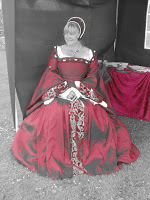 Judith Arnopp’s life-long passion for history eventually led her to the University of Wales where she gained a BA in English and Creative Writing, and a Masters in Medieval History.
Judith Arnopp’s life-long passion for history eventually led her to the University of Wales where she gained a BA in English and Creative Writing, and a Masters in Medieval History.Her first novel, Peaceweaver was published in 2009, quickly followed by The Forest Dwellers and The Song of Heledd but she remained largely unknown as an author until her first best-selling Tudor novel,The Winchester Goose. Since then she has continued to write in the Tudor era, producing five further novels covering the lives of Anne Boleyn, Katheryn Parr and Elizabeth of York.
The Beaufort Chronicles comprises of three volumes: The Beaufort Bride, The Beaufort Woman and The King’s Mother tracing the fascinating life of Margaret Beaufort. She is currently engaged in researching the Dissolution of the monasteries for her eleventh novel which is yet to be named.
Judith’s non-fiction work has also been published in various historical anthologies, the latest beingSexuality and Its Impact on History which will be published in March 2018 by Pen and Sword Books.You will also find her work on many on-line magazines and blogs. Judith is easily accessible on her webpage and blog or you can follow her on social media: Website Website Blog Facebook Twitter

11th December
Elizabeth St.John
 Elizabeth St.John was brought up in England and lives in California. To inform her writing, she has tracked down family papers and residences from Nottingham Castle, Lydiard Park, and Castle Fonmon to the Tower of London. Although the family sold a few castles and country homes along the way (it's hard to keep a good castle going these days), Elizabeth's family still occupy them - in the form of portraits, memoirs, and gardens that carry their imprint. And the occasional ghost.
Elizabeth St.John was brought up in England and lives in California. To inform her writing, she has tracked down family papers and residences from Nottingham Castle, Lydiard Park, and Castle Fonmon to the Tower of London. Although the family sold a few castles and country homes along the way (it's hard to keep a good castle going these days), Elizabeth's family still occupy them - in the form of portraits, memoirs, and gardens that carry their imprint. And the occasional ghost.Elizabeth’s debut novel, The Lady of the Tower, has been an Amazon best seller since its release in 2016, and has won numerous awards for historical fiction. By Love Divided, the second in The Lydiard Chronicles series, follows the fortunes of the St.John family during the English Civil War, and was featured a the 2018 Swindon Festival of Literature as well as recognized with an “Editors’ Choice” by the Historical Novel Society. Elizabeth’s currently working on the next in the series, telling of the lives of the St.John women after the Civil War and into the Restoration.
Keep in touch with Elizabeth: Website, Amazon Author Page, Twitter, Facebook.

12th December
Tabetha Waite
 Award-winning author, Tabetha Waite, is included in this set, featuring a Ways of Love prequel novella. Find out what happened between Cassie and Gregory before "Why the Earl is After the Girl!"
Award-winning author, Tabetha Waite, is included in this set, featuring a Ways of Love prequel novella. Find out what happened between Cassie and Gregory before "Why the Earl is After the Girl!" Tabetha makes her home in Missouri with her husband and two daughters and loves to hear from her readers! Join her mailing list for updates and special content!

13th December
Anne O’Brien
 Anne O’Brien was born in West Yorkshire. After gaining a BA Honours degree in History at Manchester University and a Master’s in Education at Hull, she lived in East Yorkshire for many years as a teacher of history.
Anne O’Brien was born in West Yorkshire. After gaining a BA Honours degree in History at Manchester University and a Master’s in Education at Hull, she lived in East Yorkshire for many years as a teacher of history.She now lives with her husband in an eighteenth-century timber-framed cottage in the depths of the Welsh Marches in Herefordshire, on the borders between England and Wales, where she writes historical novels. The perfect place in which to bring medieval women back to life.
Anne loves to hear from readers, you can find her: Website • Facebook • Twitter

14th December
Cynthia Ripley Miller
 Cynthia Ripley Miller’s short fiction has appeared in anthologies and ezines. A Ring of Honor-Circle of Books Award winner and Chanticleer International Chatelaine Award finalist for her novel, On the Edge of Sunrise, she has reviewed for UNRV Roman History, and blogs at Historical Happenings and Oddities: A Distant Focus and on her website, click HERE!
Cynthia Ripley Miller’s short fiction has appeared in anthologies and ezines. A Ring of Honor-Circle of Books Award winner and Chanticleer International Chatelaine Award finalist for her novel, On the Edge of Sunrise, she has reviewed for UNRV Roman History, and blogs at Historical Happenings and Oddities: A Distant Focus and on her website, click HERE!On the Edge of Sunrise and The Quest for the Crown of Thorns are the first two novels in her Long-Hair Saga series set in Late Ancient Rome and France.
Also connect with Cynthia on: Twitter • Facebook

16th December
Matthew Harffy
 Matthew Harffy lived in Northumberland as a child and the area had a great impact on him. The rugged terrain, ruined castles and rocky coastline made it easy to imagine the past. Decades later, a documentary about Northumbria's Golden Age sowed the kernel of an idea for a series of historical fiction novels. The first of them is the action-packed tale of vengeance and coming of age, THE SERPENT SWORD.
Matthew Harffy lived in Northumberland as a child and the area had a great impact on him. The rugged terrain, ruined castles and rocky coastline made it easy to imagine the past. Decades later, a documentary about Northumbria's Golden Age sowed the kernel of an idea for a series of historical fiction novels. The first of them is the action-packed tale of vengeance and coming of age, THE SERPENT SWORD.Matthew has worked in the IT industry, where he spent all day writing and editing, just not the words that most interested him. Prior to that he worked in Spain as an English teacher and translator. Matthew lives in Wiltshire, England, with his wife and their two daughters.
Matthew loves to hear from readers, you can find him: Website • Facebook • Twitter

17th December
Sarah Dahl
 Sarah Dahl lives on the edge of the rural German Eifel and writes historical fiction primarily set in the Viking age. She also works as an editor, translates, and coaches new writers in German and English. She is interested in everyday life in bygone centuries and the human stories that may have occurred behind the hard, historical facts.
Sarah Dahl lives on the edge of the rural German Eifel and writes historical fiction primarily set in the Viking age. She also works as an editor, translates, and coaches new writers in German and English. She is interested in everyday life in bygone centuries and the human stories that may have occurred behind the hard, historical facts.Connect with Sarah: Website/Blog • Books • Mailing List • Facebook • Twitter • Goodreads

18th December
Simon Turney
 A born and bred Yorkshireman with a love of country, history and architecture, Simon spends most of his rare free time travelling around ancient sites, writing, researching the ancient world and reading voraciously.
A born and bred Yorkshireman with a love of country, history and architecture, Simon spends most of his rare free time travelling around ancient sites, writing, researching the ancient world and reading voraciously.Following an arcane and eclectic career path that wound through everything from sheep to Microsoft networks and from paint to car sales, Simon wrote Marius' Mules. Now, with in excess of twenty novels under his belt, Simon writes full time. He lives with his wife and children and a menagerie of animals in rural North Yorkshire.
Find Simon: Website • Blog • Facebook • Twitter.

19th December
Pam Lacey
 Pam Lecky is an Irish historical fiction author, writing crime, mystery, romance and the supernatural. She is a member of the Historical Novel Society and the Society of Authors and has a particular love of the late Victorian era/early 20th Century. Her debut novel, The Bowes Inheritance, was awarded the B.R.A.G Medallion; shortlisted for the Carousel Aware Prize 2016; and long-listed for the Historical Novel Society 2016 Indie Award. Her short stories are available in an anthology, entitled Past Imperfect, which was published in April 2018. She is currently working on a Victorian mystery series. Pam is represented by the Hardman & Swainson Literary Agency in London.
Pam Lecky is an Irish historical fiction author, writing crime, mystery, romance and the supernatural. She is a member of the Historical Novel Society and the Society of Authors and has a particular love of the late Victorian era/early 20th Century. Her debut novel, The Bowes Inheritance, was awarded the B.R.A.G Medallion; shortlisted for the Carousel Aware Prize 2016; and long-listed for the Historical Novel Society 2016 Indie Award. Her short stories are available in an anthology, entitled Past Imperfect, which was published in April 2018. She is currently working on a Victorian mystery series. Pam is represented by the Hardman & Swainson Literary Agency in London.Connect with Pam:FacebookTwitter www.pamlecky.comGoodreads

20th December
Anna Campbell
 Australian Anna Campbell has written 10 multi award-winning historical romances for Grand Central Publishing and Avon HarperCollins, and 20 bestselling independently published novellas. She’s also written 2 full-length independently published novels, Lord Garson’s Bride, the last instalment in her bestselling Dashing Widows series, and The Laird’s Willful Lass, the first book in The Lairds Most Likely. Look out for her novella, The Laird’s Christmas Kiss, in late October, the second story in this new Scottish-set series.
Australian Anna Campbell has written 10 multi award-winning historical romances for Grand Central Publishing and Avon HarperCollins, and 20 bestselling independently published novellas. She’s also written 2 full-length independently published novels, Lord Garson’s Bride, the last instalment in her bestselling Dashing Widows series, and The Laird’s Willful Lass, the first book in The Lairds Most Likely. Look out for her novella, The Laird’s Christmas Kiss, in late October, the second story in this new Scottish-set series.Anna loves to hear from readers, you can find her: Website • Facebook • Twitter.

21st December
Teresa McRae
 I am 61 and married with one adult child and one beautiful granddaughter. I have always enjoyed the written word and am a voracious reader from my early youth. I am inspired by many authors in the historical fiction genre. I am also a lover of Russian literature, particularly Tolstoy. I find great inspiration for creating characters. There is such a depth to his works. I have written for most of my life in one form or another. I have dabbled in poetry and songwriting, and have more started novels than finished ones. In my free time, I like reading, history, crossword puzzles and travel. I am interested in genealogy and working on my family tree. I live in the Midwest United States with my husband, Chris and my dog Max.
I am 61 and married with one adult child and one beautiful granddaughter. I have always enjoyed the written word and am a voracious reader from my early youth. I am inspired by many authors in the historical fiction genre. I am also a lover of Russian literature, particularly Tolstoy. I find great inspiration for creating characters. There is such a depth to his works. I have written for most of my life in one form or another. I have dabbled in poetry and songwriting, and have more started novels than finished ones. In my free time, I like reading, history, crossword puzzles and travel. I am interested in genealogy and working on my family tree. I live in the Midwest United States with my husband, Chris and my dog Max.Teresa loves to hear from readers, you can find her: Website • Twitter.

27th December
The Coffee Pot Book Club

Historical Fiction Book Of The Year Award 2018

28th December
The Coffee Pot Book Club
 Historical Romance Book Of The Year Award 2018
Historical Romance Book Of The Year Award 2018
29th December
The Coffee Pot Book Club

Historical Non-Fiction Book Of The Year Award
Published on November 30, 2018 23:00
November 29, 2018
Pirates: Lovable scoundrels, or cut-throat villains? by Julia Maiola #amwriting #Pirates #history @CaptainMaiola
Pirates: Lovable scoundrels, or cut-throat villains?
By Julia Maiola

What would a villain have to do to lose support from a sympathetic audience?
We as humans have a love for the underdog, for the misunderstood hero. We look to the Golden Age of Piracy for adventure, romance, and treasure. We root for the small thieves, the soul-tortured swashbucklers, and cheer when they do the right thing or grow a heart. Pirates were just trying to live a better life, after all, and weren’t real villains.
Or were they?
When I started The Red Flag, I had one goal in mind: to give readers the truth. Pirates were some of the cruelest people who ever lived. And they enjoyed being cruel.
We know that pirates were criminals. Yet we dress like them, talk like them, make exciting movies about them. As I myself got caught up in this popular culture, I started to wonder why there seemed to be such a celebration of these murderers and thieves. My research turned to myths vs. facts, and I realized that not only was there this strange interest and infatuation with piracy, but that the pop culture surrounding it was wrong. People aren’t dressing as murderers, but treasure-hunters. Not thieves, but hopeless romantics. Everything I saw in pop culture had nothing to do with pirates at all. This popular image had influenced people’s perception of pirates to the point of changing how they view them. So I decided to write a story about pirates that accurately portrayed the real rogues of the sea as they truly lived three hundred years ago.
I wanted to give readers a detailed depiction of what pirates were like and what sent them on this path of violence. I created a pirate captain, Stephen Boswell, who is motivated by fear in order to push him to do things that will shock and abhor readers. This is no adventure, and the motivation is no treasure. This is a dangerous, deadly voyage in which each kill is simply another day and each day still alive is a success.
Having created Stephen, I needed a character to completely contrast him, to be at odds with his evil, to give readers two sides of the same story, as far from each other as possible. Who better than Alice Bradford, a child, the epitome of innocence and naive goodwill. While Alice experiences the violence of the pirates firsthand, it is Stephen Boswell’s own recounting of what led him to this life that may draw the reader to his side. I think we subconsciously come to sympathize with those whose perspective we share, and I took advantage of this by putting Stephen’s accounts in the first person. My hope was to confuse readers over who to ultimately root for. On the one hand is little Alice who we want to protect from the villainous pirates. On the other is Stephen who shares his own experiences of being mistreated by the hypocritically villainous nature of the British navy. Readers will know and agree that Stephen is the villain, but they will wonder, and maybe even hope, if he can conquer his fears and escape the navy for good.
This was a deliberate effort on my part because while I wanted to expose the true nature of piracy, I also wanted to raise questions about human nature itself, both in the pirate characters and in the readers. Despite Stephen’s actions, we as humans want to see another human succeed, even as Stephen acts against other humans despite his own humanity.
But what would a villain have to do to lose support from a sympathetic audience?
What line would have to be crossed? That is, if the simple act of being a pirate didn’t mean he had already crossed it. For as I hope readers will come to understand as they read The Red Flag, pirates may have been humans, but they committed atrocities against their fellow humans. They were true villains, and not the swashbucklers that pop culture has come to idealize.
The Red Flag
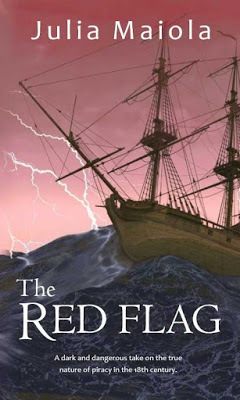 Captain Stephen Boswell sails under the red flag, a symbol of no mercy. It’s the only reason he has lived this long. The only reason the navy has not found him yet. But they are closing in. And if they catch him, they will execute him for piracy.
Captain Stephen Boswell sails under the red flag, a symbol of no mercy. It’s the only reason he has lived this long. The only reason the navy has not found him yet. But they are closing in. And if they catch him, they will execute him for piracy.Ten-year-old Alice Bradford doesn’t know why she is alive. When Captain Boswell found her hiding on his ship, she expected him to kill her, and it seemed his own crew had expected likewise. But now she is his prisoner and she fears that she will be forever. Somehow, though, it seems that the captain might be more afraid of the navy than she is of him. Something from his past has him ill at ease, Alice realizes. Even if the navy cannot bring him to his knees, his own paranoia will.
Amazon UK • Amazon US
Julia Maiola
 Julia Maiola is a professional ice cream scooper from Rochester, New York. She will receive her Bachelor’s in English at the end of 2018 and will continue to develop her writing. The Red Flag is her first novel, the first of many to come. A science fiction title is currently in the works and will be followed by more in the fantasy and historical fiction genres. When Julia is not writing, she is gaming and skateboarding, but most of her spare time is spent reading adventure novels.
Julia Maiola is a professional ice cream scooper from Rochester, New York. She will receive her Bachelor’s in English at the end of 2018 and will continue to develop her writing. The Red Flag is her first novel, the first of many to come. A science fiction title is currently in the works and will be followed by more in the fantasy and historical fiction genres. When Julia is not writing, she is gaming and skateboarding, but most of her spare time is spent reading adventure novels.Julia loves to hear from readers, you can find her: Website • Twitter • Goodreads• Facebook • Instagram
Published on November 29, 2018 23:00
November 28, 2018
Myths, Legends, Books & Coffee Pots has been named one of the top 35 Historical Book Blogs on the web by Feedspot #HistoricalFiction #BookBlogging @_feedspot
I am very excited to announce that Myths, Legends, Books & Coffee Pots has been named one of the top 35 Historical Book Blogson the web by Feedspot.

“TheBest Historical Book Blogs from thousands of Historical Book blogs on the web using search and social metrics. Subscribe to these websites because they are actively working to educate, inspire, and empower their readers with frequent updates and high-quality information.
These blogs are ranked based on following criteria
Google reputation and Google search rankingInfluence and popularity on Facebook, twitter and other social media sitesQuality and consistency of posts.Feedspot’s editorial team and expert review...”
Feedspot
I am absolutely delighted with the reward. A big thank you to everyone who has supported Myths, Legends, Books & Coffee Pots over the years. You are the best!
Thank you once again for all your support.
All the best,
Mary Anne
Published on November 28, 2018 23:00
November 27, 2018
Robert Aske – lawyer, rebel, martyr by Judith Arnopp #History #Tudors @JudithArnopp
Robert Aske – lawyer, rebel, martyr.By Judith ArnoppThe Tudor period is renowned for inventive methods of punishing those who went against the crown. For the lowly law breaker there was the pillory, the whipping post and the branding iron and we have all heard of the burning of heretics during the time of The Reformation. Another method of capital punishment was boiling; the living victim was lowered into boiling water, or oil – unthinkable.
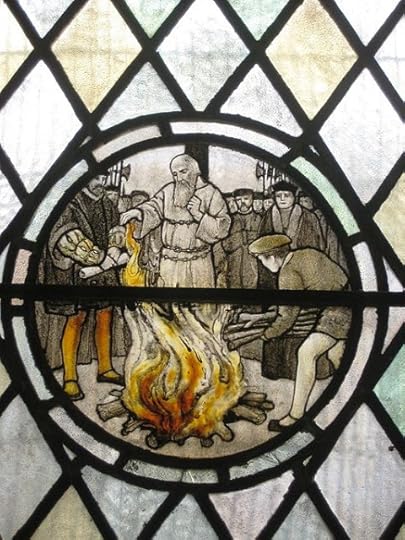
Death by Pressing was another form. The victim was laid upon a sharp stone, their body covered with a board onto which weights were piled until the offender’s bones broke and the victim eventually suffocated. This was graphically illustrated in the television drama series Gunpowder with the death of Anne Clitheroe, who was crushed to death for the crime of harbouring priests.
The Tudor era, being one of religious turmoil, was bloody indeed and needs little embellishment from the authors writing in the period. The Pilgrimage of Grace, the largest and most dangerous rebellion of the Tudor period, saw many gruesome deaths. Although only one person was killed during the uprising, the punishments the rebels received were harsh; commoners were hung, the nobles executed but it was Robert Aske, a main player in the proceedings who suffered the slowest, most excruciating death of all.
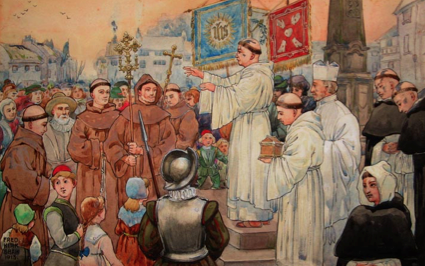
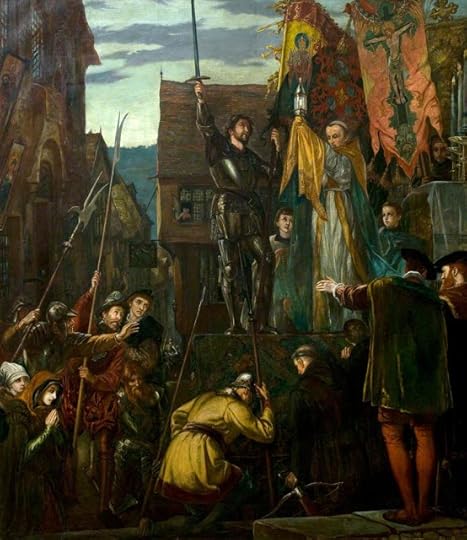
During the Lincolnshire rising, Aske and some other officials were captured by rebels and agreed to act on their behalf, writing letters to the court outlining their complaints. These letters emphasised the rebellion was not against the king but against Cromwell and the despoliation of the monasteries. Aske, who at this point had clearly never met King Henry, sought to re-educate the king and persuade him to change his mind. Erm … good luck with that!
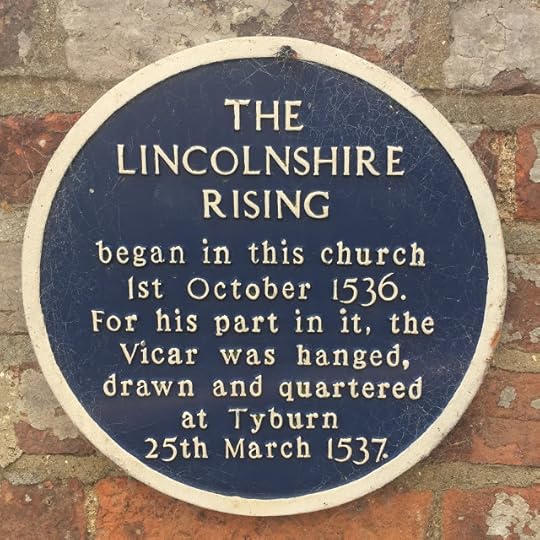
In the weeks that followed, Aske persuaded the rebels of York to join what he termed a ‘Pilgrimage of Grace’, and people flocked to his support. The movement was not only fuelled by dissatisfaction with the monastic closures but also with years of unfair taxations, unpopular reformation laws and failed harvests. Within days, an estimated 40,000 people (estimates vary) were marching on York and a short time later, following a brief siege, Thomas Darcy surrendered Pontefract Castle and joined with the rebels.
By autumn the rising had spread, covering Lancashire, Westmorland, Northumberland and Cumberland. The new tenant of Sawley Abbey was thrown out and the monks moved back in, an act that prompted the king to order the Earl of Derby to re-take the abbey and hang the abbots and the monks without trial. But Derby, lacking the man power to move against the weight of Aske’s supporters, was forced to admit his misgivings to the king.
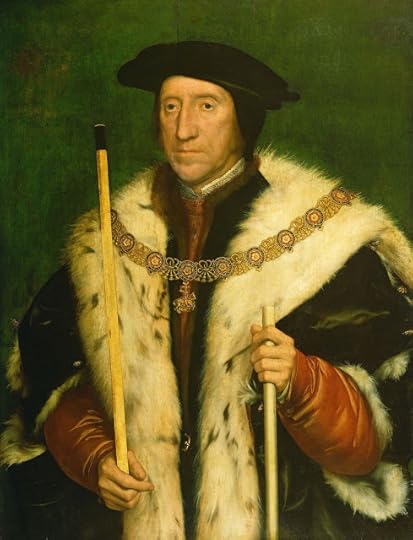 Thomas Howard. Hans Holbein
Thomas Howard. Hans Holbein This forced Henry VIII to bring the seasoned warrior, Thomas Howard, Duke of Norfolk out of retirement but Norfolk was a Catholic and an enemy of Thomas Cromwell and possibly had more sympathy with the rebels than was wise. Although he raised a large army, he claimed to have doubts as to their reliability and urged the king to negotiate with the rebels instead. On failing to persuade Darcy to hand Aske over to the king, he returned to London where he advised the king to offer a pardon to the commons, and punish the leaders once they’d dispersed.
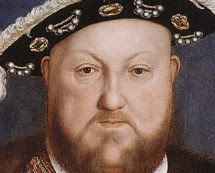
The king duly issued a pardon in early December and invited Aske to court for Christmas where he promised to consider his complaints. Like a lamb to the slaughter, Aske spent Christmas at Greenwich where he was given a warm welcome by the king who gifted him a crimson silk jacket. Aske was wooed with false promises. The king feigned agreement with the terms he put forward, and seemed to concur with his opinions of Thomas Cromwell.
Unfortunately for Aske, during his time in London further rebellion broke out in the north. This time the rebels were led by Sir Francis Bigod who viewed Aske’s gentle approach as traitorous to the cause. Aske promised the king to try and put the rebellion down and returned to Yorkshire in the company of Norfolk. On the 10th of February Bigod was imprisoned in Carlisle Castle.
In early March Norfolk invited Aske and Darcy to London to receive royal thanks for their part in quelling the rebellion but on their arrival they were arrested and sent to the Tower charged with renewed conspiracy.
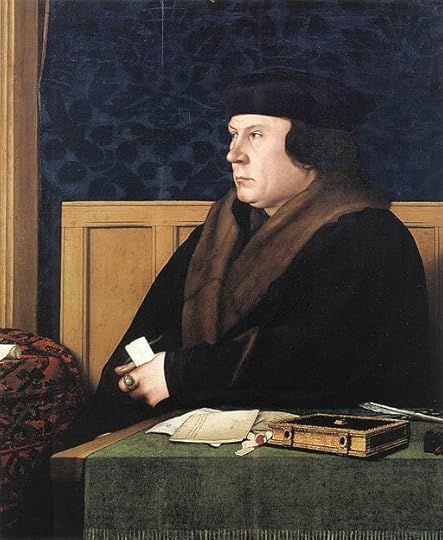 Thomas CromwellAske was examined by Thomas Cromwell. He gave honest answers to the one hundred and seven questions asked of him but Cromwell produced rebel statements implicating him in the Bigod rebellion. He also possessed a letter, allegedly signed by Aske and Darcy, imploring the people not to join Bigod. This letter, Cromwell argued, proved Aske to be a traitor because by instructing the pilgrims to remain in their homes and not join the rebels also meant they were not to assist the king’s men. In other words the letter was of treasonous intent.
Thomas CromwellAske was examined by Thomas Cromwell. He gave honest answers to the one hundred and seven questions asked of him but Cromwell produced rebel statements implicating him in the Bigod rebellion. He also possessed a letter, allegedly signed by Aske and Darcy, imploring the people not to join Bigod. This letter, Cromwell argued, proved Aske to be a traitor because by instructing the pilgrims to remain in their homes and not join the rebels also meant they were not to assist the king’s men. In other words the letter was of treasonous intent. Condemned as a traitor, Robert Aske received the death penalty, the execution to take place in York where the uprising had begun as a lesson to his followers. Opinion differs as to the exact nature of his death, some say he was hung drawn and quartered, and his remains placed in a gibbet to rot but most believe he was hung alive in chains over the walls of Clifford’s Tower, a slow, agonising death that would have taken several days.
Images, in order of appearance:Weglinde [CC0], from WikimediaShaw, Fred Kirk [Public domain], via WikimediaAndrew Benjamin Donaldson (1840-1919): Photo credit: The Collection: Art and Archaeology in Lincolnshire (Usher Gallery)Simon Cope from High Wycombe, United Kingdom Thomas Howard. Hans Holbein [Public domain]
Thomas Cromwell: Hans Holbein [Public domain]
Below is an (unedited) excerpt from Sisters of Arden.
Due for publication in December 2018
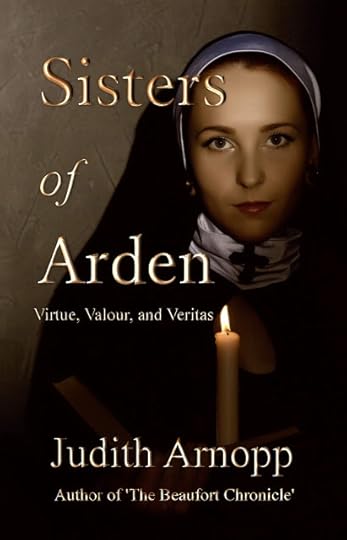
She nods toward the castle mound and for the first time, I drag my eyes from the tragedy of her face to the sombre crowd gathered beneath the walls of the keep. Some are kneeling, some stand, the murmur of their combined prayers ebbing and flowing as they focus on one object. I follow their line of vision to the towering walls of the castle, a shiver crawling over me when I notice the figure of a man hanging in chains. Horror scuttles like an insect across my skin.
His robes have been torn away, displaying the marks of violence upon his body. He is filthy, his limbs smeared with his own blood yet, as bruised and battered as he is, I know I am looking on all that remains of Robert Aske. With bile rising in the back of my throat, I stagger to my feet, but I force the sickness down. Making the sign of the cross, I call down a blessing.
“Do you think God cares?” Grace snarls. “Didn’t we pray for his help from the moment it all began? Didn’t we pray for the king’s return to grace? Haven’t I prayed every day since he was taken? God didn’t listen when there was time to save him, why should he listen now?”
“Oh Grace, sometimes the Lord’s plan is hard for us to understand. In time it will make more sense …”
She turns on me, spittle on her lips.
“This will NEVER make sense to me. Aske is a good man, an honest, religious man whose loyalty to the king NEVER wavered. Not once did he seek to undermine his rule, he merely wanted to show him the error of his ways …” Her voice breaks. I place my hand over hers and squeeze gently.
“At least his suffering is over now. Take comfort from that.”
Her head jerks up, her eyes bore into mine. Eyes full of anguish and – oh, such pain!
“Oh no, they are not, Margery. You do not understand. Aske’s suffering is very far from over. Do you not see? Look at him! He still lives: do you not see?”
My head turns stiffly, unwillingly, but I force myself to look again upon the ravaged body. Grace must be mistaken. No king would be so inhuman as to inflict that much suffering upon a man. Aske is very still but as I watch, his head moves just a little, the chains that hold him clank as he squirms feebly against his fate. His weak groans evoke further prayer from the crowd – disciples, I see now, who are sharing his suffering.
Grace lowers her head, her words so quiet I can scarcely hear them.
“That is why I cannot leave. Until he has gone from this world all of us gathered here will bear witness to his death. When he has gone we will take word of it, spread the reality of what has happened across the country, across the world. Every man and woman must know the true nature of the king of England.”
Those of us who hold vigil during those last hours of Aske’s life feel each moment of his suffering, inhale with him each tortured rasping breath. Beyond thirst, beyond hunger, his existence is reduced only to suffering. Each time he lapses into unconsciousness, the cruel changing wind sets his broken body swaying and the chains bite deeper into his flesh. When Aske cries out, we all weep with him.
We pray for the lord to take him, pray for it to be over and when he is silent at last, we thank God for ending his torment, and ours.
Judith Arnopp is the author of:
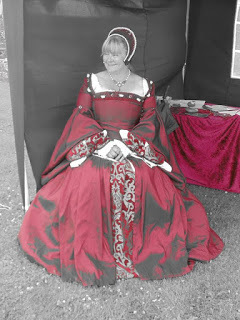 The Beaufort Chronicles (three book series)A Song of Sixpence: the story of Elizabeth of York and Perkin WarbeckThe Kiss of the Concubine: A story of Anne BoleynTheWinchester Goose: at the court of Henry VIIIIntractable Heart: the story of Katheryn ParrTheSong of HeleddPeaceweaverTheForest Dwellers
The Beaufort Chronicles (three book series)A Song of Sixpence: the story of Elizabeth of York and Perkin WarbeckThe Kiss of the Concubine: A story of Anne BoleynTheWinchester Goose: at the court of Henry VIIIIntractable Heart: the story of Katheryn ParrTheSong of HeleddPeaceweaverTheForest DwellersFor more information on Judith and her books visit: Website • Blog • Amazon <!-- /* Font Definitions */ @font-face {font-family:"Cambria Math"; panose-1:2 4 5 3 5 4 6 3 2 4; mso-font-charset:0; mso-generic-font-family:auto; mso-font-pitch:variable; mso-font-signature:-536870145 1107305727 0 0 415 0;} @font-face {font-family:Calibri; panose-1:2 15 5 2 2 2 4 3 2 4; mso-font-charset:0; mso-generic-font-family:auto; mso-font-pitch:variable; mso-font-signature:-520092929 1073786111 9 0 415 0;} @font-face {font-family:Garamond; panose-1:2 2 4 4 3 3 1 1 8 3; mso-font-charset:0; mso-generic-font-family:auto; mso-font-pitch:variable; mso-font-signature:3 0 0 0 1 0;} /* Style Definitions */ p.MsoNormal, li.MsoNormal, div.MsoNormal {mso-style-unhide:no; mso-style-qformat:yes; mso-style-parent:""; margin-top:0cm; margin-right:0cm; margin-bottom:10.0pt; margin-left:0cm; line-height:115%; mso-pagination:widow-orphan; font-size:11.0pt; font-family:Calibri; mso-ascii-font-family:Calibri; mso-ascii-theme-font:minor-latin; mso-fareast-font-family:Calibri; mso-fareast-theme-font:minor-latin; mso-hansi-font-family:Calibri; mso-hansi-theme-font:minor-latin; mso-bidi-font-family:"Times New Roman"; mso-bidi-theme-font:minor-bidi;} .MsoChpDefault {mso-style-type:export-only; mso-default-props:yes; font-size:11.0pt; mso-ansi-font-size:11.0pt; mso-bidi-font-size:11.0pt; font-family:Calibri; mso-ascii-font-family:Calibri; mso-ascii-theme-font:minor-latin; mso-fareast-font-family:Calibri; mso-fareast-theme-font:minor-latin; mso-hansi-font-family:Calibri; mso-hansi-theme-font:minor-latin; mso-bidi-font-family:"Times New Roman"; mso-bidi-theme-font:minor-bidi;} .MsoPapDefault {mso-style-type:export-only; margin-bottom:10.0pt; line-height:115%;} @page WordSection1 {size:612.0pt 792.0pt; margin:72.0pt 90.0pt 72.0pt 90.0pt; mso-header-margin:36.0pt; mso-footer-margin:36.0pt; mso-paper-source:0;} div.WordSection1 {page:WordSection1;} </style></span></div><br /><br />
Published on November 27, 2018 23:00
November 26, 2018
A conversation with Historical Fiction author, Samantha Grosser. #Giveaway #biblical #HistoricalFiction @hfvbt @SamanthaGrosser
Historical Fiction Virtual Blog Tours Presents…

A conversation with Historical Fiction author, Samantha Grosser
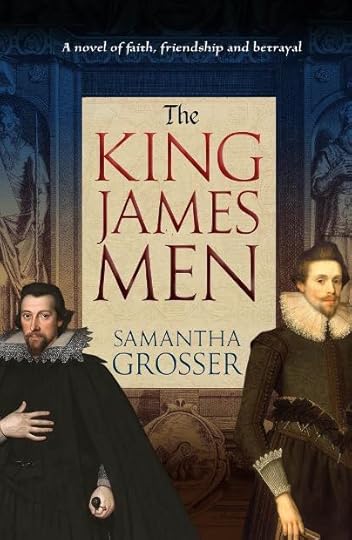
Connected by love, divided by faith. A novel of faith, friendship, and betrayal set against the religious turbulence of 17th Century London.
England 1604
Two men, once friends, have long since gone their separate ways. But when the new King James commands a fresh translation of the Bible, their paths are fated to cross again.
For biblical scholar Richard Clarke, the chance to work on the new translation seems like a gift from God, a way back in from the cold where his friendship with Separatist Ben Kemp has kept him for many years. But Richard soon discovers there is a price to pay for his new-found favour, and that price is betrayal. Caught between love for his friend and his faith in his Church, Richard must make a decision that could cost him his soul.
Set against the background of the writing of the King James Bible, and inspired by true accounts of the community who became the Mayflower Pilgrims, The King James Men is a vivid portrayal of the religious struggles of the age, and the price of being true to your faith.
***
Hi Samantha, welcome to Myths, Legends, Books & Coffee Pots. Please feel free to introduce yourself to my readers.
Hi Mary Anne, thank you so much for being a part of my tour!
I was born and brought up in England, but after studying for an Honours Degree in English in London, I spent several years travelling and working as an English teacher in South East Asia, Japan and Australia.
I’ve been writing for as long as I can remember, and I’m passionate about creating compelling and authentic stories that are set against momentous events in history. Writing historical fiction seems to me to be the perfect way to blend a lifelong love of literature with a slightly obsessive interest in research about the past.
These days you can find me on the sunny Northern Beaches of Sydney where I live with my Australian husband and son, and a very small dog called Livvy.e days you can find me on the sunny Northern Beaches of Sydney where I live with my Australian husband and son, and a very small dog called Livvy.
 Sydney's Northern Beaches
Sydney's Northern BeachesIt is so empowering writing historical fiction and as you say, it make a great excuse to spend hours researching! What inspired you to write the The King James Men?
I honestly can’t recall the original spark that set things off, though I remember thinking that the creation of a book as important and enduring as the King James Bible must be a story worth the telling. But the challenge was to create a compelling novel within that story, and in the mountains of research I collected about the period, I discovered the story of the small community of nonconformists who would later go on to become the Mayflower Pilgrims. The story of The King James Men was born in the conflict between the world of the translation and the world of the Separatists.
Your book sounds amazing. Did you face many challenges while researching this period of history?
As well as the usual challenges for any historical fiction author – what did they wear and eat? What was their routine? What were the customs of the day? The King James Men presented particular difficulties because of the conflict of ideas at the heart of the book. For a modern-day outsider, the differences that caused the schism in the English church can be hard to appreciate, but for those involved it was a matter of life and death, a choice that could cost them their souls.
So the challenge for me was to interpret those differences in a way that was personal, and to imbue the characters with the spirit of their beliefs, so that readers would feel the desperation of making the right choice.
The Church had such a hold on the populace, it was certainly a very different world to the one we live in now.Can you share with us three things that sets The King James Men apart from other books set in the 16th Century.
1. The King James Men is set against the translation of the King James Bible, the most influential book in Western history, and was inspired by the story of the community who went on to become the Mayflower pilgrims.
2. It’s a novel of friendship and faith, and of love and hope.
3. It’s a vivid portrayal of the religious turbulence of the age, and the price of being true to your faith.
The more I hear about this book, the more I want to read it! Last question, could you tell us what you are currently working on?
Currently, I’m working on another novel set in England in the 17th Century. It’s still in the early stages of the first draft, and so I don’t want to jinx it by saying too much!
Thank you so much for coming onto the blog, I really enjoyed our conversation. I, and I am sure my readers do as well, wish you all the best with your fabulous new book!
Giveaway
During the Blog Tour we will be giving away one eBook & one paperback copy of The King James Men! You can enter:
HERE!
Giveaway Rules
• Giveaway ends at 11:59pm EST on December 4th. You must be 18 or older to enter.• Giveaway is open to US residents only.• Only one entry per household.• All giveaway entrants agree to be honest and not cheat the systems; any suspect of fraud is decided upon by blog/site owner and the sponsor, and entrants may be disqualified at our discretion.• Winner has 48 hours to claim prize or new winner is chosen.
Samantha Grosser
Historical fiction author Samantha Grosser originally hails from England, but now lives on the sunny Northern Beaches of Sydney with her husband, son and a very small dog called Livvy.Combining a lifelong love of history with a compulsion to write that dates from childhood, Samantha is now bringing her passion for telling compelling stories to the world.
Samantha has an Honours Degree in English Literature and taught English for many years in Asia and Australia. She is the author of wartime dramas Another Time and Place, and The Officer’s Affair. The King James Men, set during the turbulent years of the early years of 17th Century, is her third novel.
WEBSITE • FACEBOOK • INSTAGRAM • PINTEREST • GOODREADS
Published on November 26, 2018 23:00
The Coffee Pot Book Club
The Coffee Pot Book Club (formally Myths, Legends, Books, and Coffee Pots) was founded in 2015. Our goal was to create a platform that would help Historical Fiction, Historical Romance and Historical
The Coffee Pot Book Club (formally Myths, Legends, Books, and Coffee Pots) was founded in 2015. Our goal was to create a platform that would help Historical Fiction, Historical Romance and Historical Fantasy authors promote their books and find that sometimes elusive audience. The Coffee Pot Book Club soon became the place for readers to meet new authors (both traditionally published and independently) and discover their fabulous books.
...more
...more
- Mary Anne Yarde's profile
- 159 followers



